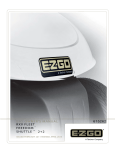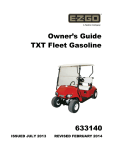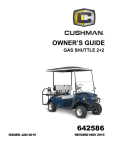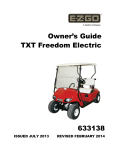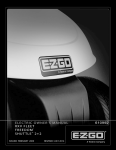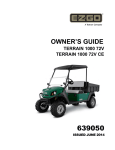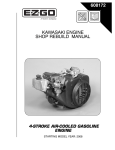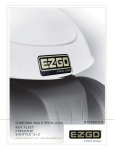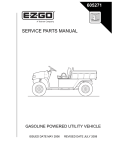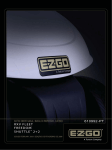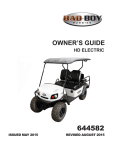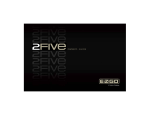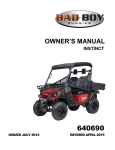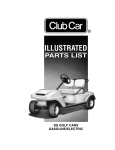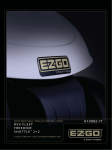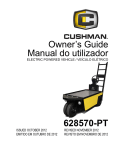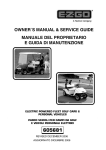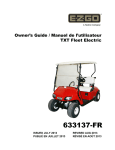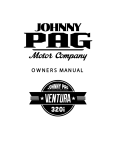Download Manual - E-Z-Go
Transcript
OWNER’S GUIDE RXV GASOLINE POWERED VEHICLE ISSUED MAY 2015 646286 REVISED NOVEMBER 2015 WELCOME Thank you for purchasing this vehicle. Before you drive the vehicle, read this Owner’s Guide. This guide contains maintenance and operation information. The illustrations can show items that are optional for your vehicle. You can do most of the service procedures in this guide with common, automotive hand tools. If necessary, contact your service representative for information about how to service the vehicle as shown in the Periodic Service Schedule. Repair or replacement parts are available from your E-Z-GO dealer or E-Z-GO Service Parts Department. When you contact E-Z-GO about service or parts for your vehicle, the information below is needed. Vehicle Model: ___________________________________________________________ PIN, VIN or Serial Number: _________________________________________________ OWNER’S GUIDE GASOLINE POWERED VEHICLES RXV FLEET RXV FREEDOM RXV SHUTTLE 2+2 STARTING MODEL YEAR 2016 CALIFORNIA Proposition 65 Warning WARNING: Motor vehicles may contain fuels, oils and fluids, battery posts, terminals, and related accessories which contain lead, lead compounds and other chemicals identified by the State of California to potentially cause cancer, birth defects and other reproductive harm. These chemicals are found in vehicles, vehicle parts and accessories, both new and replacements. During maintenance, these vehicles generate used oil, waste fluids, grease, fumes and particulates, all identified by the State of California to potentially cause cancer, birth defects, and other reproductive harm. Never modify the vehicle in any way that will alter the weight distribution of the vehicle, decrease its stability or increase the speed beyond the factory specifications. Such modifications can cause serious personal injury or death. E-Z-GO Division of Textron, Inc. prohibits and disclaims responsibility for any such modifications or any other alteration which would adversely affect the safety of the vehicle. E-Z-GO Division of Textron, Inc. reserves the right to incorporate engineering and design changes to products in this manual, without obligation to include these changes on units sold previously. The information contained in this manual may be revised periodically by E-Z-GO Division of Textron, Inc., and therefore is subject to change without notice. E-Z-GO Division of Textron, Inc. DISCLAIMS LIABILITY FOR ERRORS IN THIS MANUAL, and SPECIFICALLY DISCLAIMS LIABILITY FOR INCIDENTAL AND CONSEQUENTIAL DAMAGES resulting from the use of the information and materials in this Manual. These are the original instructions as defined by 2006/42/EC. TO CONTACT US E-Z-GO Division of Textron Inc. 1451 Marvin Griffin Road. Augusta, Georgia, USA 30906-3852 North America: Technical Assistance & Warranty PHONE: 1-800-774-3946 FAX: 1-800-448-8124 Service Parts PHONE: 1-888-GET-EZGO (1-888-438-3946) FAX: 1-800-752-6175 International PHONE: 001-706-798-4311 FAX: 001-706-771-4609 i NOTES This vehicle was designed and manufactured in the United States of America (USA). The standards and specifications listed in the following text originate in the USA unless otherwise indicated. Use Original Equipment Manufacturer (OEM) approved parts to keep the warranty effective. Overfilling the battery can void the warranty. Tampering with or adjusting the governor to permit the vehicle to operate at above factory specifications will void the vehicle warranty. When servicing engines, all adjustments and replacement components must be per original vehicle specifications in order to maintain the United States of America Federal and State emission certification applicable at the time of manufacture. BATTERY PROLONGED STORAGE Batteries discharge over time. The rate of discharge changes according to the ambient temperature, the age and condition of the batteries. Completely charged batteries will not freeze in winter temperatures unless the temperature is less than -75°F (- 60°C). BATTERY DISPOSAL Lead-acid batteries are recyclable. Return discarded batteries to distributor, manufacturer or lead smelter for recycling. For neutralized spills, put residue in acid-resistant containers with absorbent material such as sand. Dispose of in accordance with local, state and federal regulations for acid and lead compounds. Contact local or state environmental officials for the disposal information. ii Owner’s Manual TABLE OF CONTENTS SAFETY B GENERAL ......................................................................................................................... 1 NOTICES, CAUTIONS, WARNINGS AND DANGERS .................................................... 1 GENERAL OPERATION................................................................................................... 3 MAINTENANCE ................................................................................................................ 4 VENTILATION................................................................................................................... 5 LABELS AND PICTOGRAMS........................................................................................... 6 GENERAL SPECIFICATIONS APPROXIMATE VEHICLE DIMENSIONS ...................................................................... 17 TURNING DIAMETER AND INCLINE INFORMATION .................................................. 19 INTRODUCTION CONTROLS AND INDICATORS .................................................................................... 21 FEATURES ..................................................................................................................... 22 General Information ........................................................................................... 22 OPERATING PROCEDURES SERIAL NUMBER LOCATION ....................................................................................... 27 BEFORE INITIAL USE.................................................................................................... 28 HOW TO OPERATE THE VEHICLE............................................................................... 28 Direction Selector Operation .............................................................................. 29 Accelerator Pedal Operation .............................................................................. 30 Brake and Parking Brake Operation .................................................................. 30 Horn (if equipped) .............................................................................................. 30 Rear Seat and Cargo Platform Operation .......................................................... 30 12-Volt Power Outlet .......................................................................................... 31 STARTING AND DRIVING ............................................................................................. 31 Run-In ................................................................................................................ 32 Cold-Start ........................................................................................................... 32 Starting Vehicle On A Hill ................................................................................... 33 Coasting ............................................................................................................. 33 FUEL ............................................................................................................................... 33 FUEL TANK .................................................................................................................... 34 Early Production Fuel Tank ................................................................................ 34 Late Production Fuel Tank ................................................................................. 34 BATTERY........................................................................................................................ 35 Owner’s Guide iii TABLE OF CONTENTS B LABELS AND PICTOGRAMS.......................................................................................... 35 SUN TOP AND WINDSHIELD (IF EQUIPPED)............................................................... 35 MAINTENANCE VEHICLE CLEANING AND CARE................................................................................... 37 ENVIRONMENTAL CONCERNS .................................................................................... 37 Battery Disposal ..................................................................................................38 LIFTING THE VEHICLE................................................................................................... 38 How to Lift the Entire Vehicle: .............................................................................38 How to Lift the Rear of the Vehicle Only: ............................................................39 How to Lift the Front of the Vehicle Only: ...........................................................39 Lower the Vehicle: ..............................................................................................39 WHEELS AND TIRES...................................................................................................... 39 Tire Repair ..........................................................................................................40 Wheel Installation ................................................................................................40 LIGHT BULB REPLACEMENT ........................................................................................ 41 Headlight (if equipped) ........................................................................................41 Turn Signal (if equipped) .....................................................................................41 Taillight (if equipped) ...........................................................................................41 VEHICLE WITH A DISCHARGED BATTERY ................................................................. 42 TRANSPORTING VEHICLE ............................................................................................ 42 Towing ................................................................................................................42 Neutral Lock ........................................................................................................42 Hauling ................................................................................................................43 SERVICE AND MAINTENANCE ..................................................................................... 43 ROUTINE MAINTENANCE.............................................................................................. 44 Engine Specifications ..........................................................................................44 Checking the Oil Level ........................................................................................44 Changing the Oil .................................................................................................45 Starter Generator Belt Tension ...........................................................................47 Adjusting the Belt ................................................................................................48 Battery Cleaning .................................................................................................48 TIRE INSPECTION.......................................................................................................... 48 BRAKES .......................................................................................................................... 49 LUBRICATION................................................................................................................. 49 CAPACITIES AND REPLACEMENT PARTS .................................................................. 49 iv Owner’s Guide TABLE OF CONTENTS HARDWARE ................................................................................................................... 50 B AIR INTAKE AND COOLING FINS................................................................................. 50 REAR AXLE .................................................................................................................... 51 Checking the Lubricant Level ............................................................................. 51 AIR CLEANER INSPECTION AND REPLACEMENT..................................................... 51 Cleaning the Air Filter Element .......................................................................... 51 SPARK PLUGS............................................................................................................... 52 BATTERY REMOVAL AND INSTALLATION.................................................................. 52 PROLONGED STORAGE............................................................................................... 53 PERIODIC SERVICE SCHEDULE PERIODIC SERVICE SCHEDULE ................................................................................. 53 APPENDIX A DECLARATION OF CONFORMITY ................................................................................. 1 Owner’s Guide v TABLE OF CONTENTS Notes: vi Owner’s Guide SAFETY Read all of SAFETY and this section before attempting any procedure. Pay particular attention to Notices, Cautions, Warnings and Dangers. SAFETY GENERAL For any questions about material in this manual, contact an authorized representative. Read and understand all labels on the vehicle. Always replace any damaged or missing labels. Steep hills allow the vehicle to move at faster speeds than normal speeds on a flat surface. To prevent the loss of vehicle control and possible injury, speeds must be controlled to the maximum level ground speed indicated in the GENERAL SPECIFICATIONS section. Apply the brake to control the speed. If you operate the vehicle above the maximum specified speed, you can damage the drivetrain components. The damage caused by speeds more than the maximum specified can cause a loss of vehicle control, is abusive, and will not be covered under the warranty. Use caution when you tow the vehicle. Towing the vehicle above the recommended speed can cause personal injury or damage to the vehicle and other property. If the vehicle is used in a commercial environment, signs must be in position to inform of possible conditions that can be dangerous. Examples are shown below. . NOTICES, CAUTIONS, WARNINGS AND DANGERS Read the NOTICES, CAUTIONS, WARNINGS and DANGERS. The person who services a vehicle needs the mechanical skill and experience to see possible hazardous conditions. Incorrect service or repairs can cause damage to the vehicle or make the vehicle dangerous to operate. A NOTICE indicates and describes information not related to personal injury. A CAUTION indicates a dangerous condition that can cause injury that is not life threatening. A WARNING indicates a dangerous condition that can cause death or serious injury. A DANGER indicates a dangerous condition that will cause death or serious injury. Owner’s Guide 1 SAFETY Read all of SAFETY and this section before attempting any procedure. Pay particular attention to Notices, Cautions, Warnings and Dangers. Engine exhaust from this product contains chemicals known, in certain quantities, to cause cancer, birth defects, or other reproductive harm. The exhaust emissions of this vehicle’s engine complies with regulations set forth by the Environmental Protection Agency (EPA) of the United States of America (USA) at time of manufacture. Significant fines could result from modifications or tampering with the engine, fuel, ignition or air intake systems. Battery posts, terminals and related accessories contain lead and lead compounds. Wash hands after handling. The spark ignition system meets all requirements of the Canadian Interference-Causing Equipment Regulations. This manual contains recommended maintenance procedures from the manufacturer. Follow these procedures and fault isolation information to get the best service from the product. To decrease the risk of personal injury or property damage, obey all the information in this manual. Certain replacement parts can be used independently and/or in combination with other accessories to modify an E-Z-GO-manufactured vehicle to permit the vehicle to operate at or in excess of 20 mph. When an E-Z-GO manufactured vehicle is modified in any way by the Distributor, Dealer or customer to operate at or in excess of 20mph, UNDER FEDERAL LAW the modified product will be a Low Speed Vehicle (LSV) subject to the strictures and requirements of Federal Motor Vehicle Safety Standard 571.500. In these instances, pursuant to Federal law the Distributor or Dealer MUST equip the product with headlights, rear lights, turn signals, seat belts, top, horn and all other modifications for LSV’s mandated in FMVSS 571.500, and affix a Vehicle Identification Number to the product in accordance with the requirements of FMVSS 571.565. Pursuant to FMVSS 571.500, and in accordance with the State laws applicable in the places of sale and use of the product, the Distributor, Dealer or customer modifying the vehicle also will be the Final Vehicle Manufacturer for the LSV, and required to title or register the vehicle as mandated by State law. E-Z-GO will NOT approve Distributor, Dealer or customer changes that change an E-Z-GO product into a Low Speed Vehicle (LSV). Anyone who operates this vehicle must be A LICENSED DRIVER AND OPERATE THE VEHICLE ACCORDING TO APPLICABLE STATE REQUIREMENTS. This rule is important to the SAFE USE AND OPERATION of the product. All customers must obey this SAFETY RULE. Information on FMVSS 571.500 is found at Title 49 of the Code of Federal Regulations, section 571.500. For information online, go to www.ecfr.gov. Vehicles are used for different purposes, so it is not possible to know and inform of every possible occurrence. Be careful when you drive to prevent avoidable personal injury or damage to the vehicle. All users must read and obey this manual. Make sure you give special attention to the CAUTIONS, WARNINGS and DANGERS. For questions about this vehicle, contact your E-Z-GO/CUSHMAN dealer or write to the address on the back cover of this publication, Attention: Customer Care Department. 2 Owner’s Guide SAFETY Read all of SAFETY and this section before attempting any procedure. Pay particular attention to Notices, Cautions, Warnings and Dangers. E-Z-GO reserves the right to make design changes without obligation to make these changes on units previously sold. The information contained in this manual is subject to change without notice. B E-Z-GO IS NOT LIABLE FOR ERRORS IN THIS MANUAL. E-Z-GO IS NOT LIABLE FOR INCIDENTAL OR CONSEQUENTIAL DAMAGES THAT RESULT FROM THE USE OF THE MATERIAL IN THIS MANUAL. This vehicle meets the current applicable standard for safety and performance requirements. These vehicles are for off-road use. They DO NOT meet the federal Motor Vehicle Safety Standards of the United States of America (USA) and are not equipped for operation on the public streets. Some areas allow the operation of the vehicles on their streets according to local codes. Refer to GENERAL SPECIFICATIONS for capacity of the vehicle. Never modify the vehicle in any way that will alter the weight distribution of the vehicle, decrease its stability, increase the speed or extend the stopping distance beyond the factory specification. Such modifications can result in serious personal injury or death. Do not change the vehicle in any manner that changes the weight distribution, decreases stability, increases speed or extends the necessary distance to stop more than the factory specification. E-Z-GO is not responsible for changes that cause the vehicle to be dangerous. Do not let anyone below the height of 59 inches (150 cm) operate the vehicle. GENERAL OPERATION Read the following warnings before attempting to operate the vehicle: When you leave the vehicle, turn the key to the OFF position and remove the key from the vehicle. Drive the vehicle only as fast as terrain and conditions allow. Consider the terrain and traffic conditions. Consider environmental conditions that change the terrain and your ability to control the vehicle. Do not drive fast downhill. Sudden stops or change of direction can cause a loss of control. Use the brake to control the speed of the vehicle when you drive down a slope. When possible, stay in approved areas. Do not drive on steep slopes. Always keep feet, legs, hands and arms inside vehicle. Do not drive on rough terrain. Before you drive in the reverse direction, make sure the area behind the vehicle is clear. Make sure the direction selector is in the correct position before you press the accelerator pedal. Decrease speed before and during turns. Make sure you completely stop the vehicle before you move the direction selector. See GENERAL SPECIFICATIONS for the vehicle load and seat capacity. Owner’s Guide 3 SAFETY Read all of SAFETY and this section before attempting any procedure. Pay particular attention to Notices, Cautions, Warnings and Dangers. Read the following text and warnings before you service the vehicle. Normal use, wear or abuse can cause some components on the vehicle to fail. The manufacturer cannot know all possible component failures or the methods that failures can occur. A vehicle in need of repair does not function properly and can be dangerous to operate. Be careful when you service the vehicle. Be aware of your safety and the safety of other people in the area. Some components are heavy, spring loaded, corrosive, explosive, can cause high amperage or get hot. Battery acid and hydrogen gas can cause injury. Do not put your hands, face, feet or body in a location that can expose them to injury if an unexpected situation occurs. Always use the correct tools shown in the tool list and wear safety equipment. Remove all jewelry before you service the vehicle. Do not allow loose clothing or hair to contact the moving parts. Do not touch hot objects. When you service the vehicle, always wear eye protection. Be careful when you work around batteries, use solvents or compressed air. ALWAYS: • Use the vehicle in a responsible manner and keep the vehicle in safe condition for operation. • Read and obey all warnings and operation instruction labels on the vehicle. • Follow all safety rules in the area where the vehicle is operated. • When there is a risk of lightning, leave the vehicle and look for a safe location to wait until the lightning has stopped. • Drive the vehicle only as fast as terrain and conditions allow. • Apply the brake to control speed on steep grades. • Keep enough distance between vehicles. • Decrease speed in wet areas. • Be careful when you make sharp turns, or turns you are not familiar with. • Be careful when you drive on loose terrain. • Be careful when you operate the vehicle around people. MAINTENANCE ALWAYS: • Replace damaged or missing warning, caution or information labels. • Service the vehicle according to the periodic service schedule in this manual. • Make sure that approved and qualified personnel do all repairs. • Follow the manufacturer’s maintenance procedures. 4 Owner’s Guide SAFETY Read all of SAFETY and this section before attempting any procedure. Pay particular attention to Notices, Cautions, Warnings and Dangers. • Use insulated tools within the battery area to prevent sparks or battery explosion. • Use specified replacement parts. DO NOT use replacement parts of less quality. • Use recommended tools. • Make sure that tools and procedures not specified by the manufacturer, will not be a safety risk to personnel or operation of the vehicle. • Use wheel chocks and support vehicle with jack stands. NEVER get below a vehicle that is supported by a jack. Lift the vehicle according to the manufacturers instructions. • Make sure you service the vehicle in an area away from open flame or sparks. • Know that a vehicle in need of repair does not operate correctly and can be dangerous to operate. • Test drive the vehicle after any repairs or maintenance in a safe area that is free of both vehicular and pedestrian traffic. • Keep complete records of the maintenance history of the vehicle. B Vehicles are used for different purposes, so it is not possible to know and inform of every possible occurrence. Be careful when you drive to prevent avoidable personal injury or damage to the vehicle. All users must read and obey this manual. Make sure you give special attention to the CAUTIONS, WARNINGS and DANGERS. People who do maintenance or repairs on the vehicle must have skill and experience to identify and prevent conditions that can cause personal injury or death and damage to the vehicle. VENTILATION Always store gasoline vehicles in an area with good ventilation. Good ventilation prevents the accumulation of gasoline fumes within an enclosed area. Never put fuel in a vehicle in an area that is subject to flame or spark. Pay particular attention to natural gas or propane water heaters and furnaces. Never work around or operate a vehicle in an environment that does not allow ventilation of exhaust gases from the area. Carbon monoxide is a dangerous gas that can cause unconsciousness and is potentially lethal. Owner’s Guide 5 SAFETY Read all of SAFETY and this section before attempting any procedure. Pay particular attention to Notices, Cautions, Warnings and Dangers. LABELS AND PICTOGRAMS 608529 OPERATING INSTRUCTIONS BEFORE OPERATING READ all warning labels and the owner’s manual. Contact an authorized E-Z-GO dealer or visit www.ezgo.com for a replacement manual. This vehicle is equipped for personal use in most communities. However, state law or local rules may require additional equipment in your community. SAFE OPERATION Turn key to “ON” - select “forward” or “reverse” - release the parking brake (Gas vehicle only) - then slowly depress accelerator pedal. Always bring the vehicle to a complete stop BEFORE shifting the direction selector. Operate from the driver’s seat ONLY. PARKING ALWAYS fully engage the parking brake and remove the key BEFORE leaving the vehicle. In an electric vehicle set the direction selector to “neutral” and in a gasoline vehicle set the selector to “forward”. MAINTENANCE This vehicle requires regularly scheduled maintenance (see owner’s manual). ONLY qualified personnel should service this vehicle. 608529 DO NOT TAMPER WITH OR ATTEMPT TO CHANGE THE ADJUSTMENT OF THE GOVERNOR. GOVERNOR TAMPERING CAN RESULT IN SERIOUS PERSONAL INJURY AND WILL VOID THE VEHICLE WARRANTY. 608527 608527 Failure to follow these instructions can result in SERIOUS INJURY or DEATH Except where PERMITTED BY LAW: Reduce the RISK OF ACCIDENTS: AVOID FALLS from the vehicle: STARTING the vehicle: DO NOT OVERLOAD this vehicle: Drive with CAUTION: STOPPING the vehicle: PARKING the vehicle: To be operated by persons with valid drivers license, in accordance with state requirements. Operate from Driver’s side only. For non-road use, and in designated areas only. Do not operate under the influence of drugs or alcohol. All occupants must be fully seated, keep entire body inside vehicle and hold on while vehicle is in motion. Apply service brake , move direction selector to desired position and accelerate smoothly. On Gas Vehicle, direction selector is the F-N-R. On Electric vehicle, direction selector is the key switch. Maximum vehicle payload is 800 lbs. (363 kg) including a maximum of 2 persons, options, and accessories. Drive slowly straight up and down slopes and in turns. Use care in reverse, congested areas, and wet or loose terrain. To stop, release accelerator pedal and apply service brake. Before leaving vehicle , turn key ‘OFF’. On Gas vehicle, move the direction selector to “FORWARD” and engage park brake.608522 608522 Fleet Vehicles Failure to follow these instructions can result in SERIOUS INJURY or DEATH 608528 Except where PERMITTED BY LAW: NEVER drive on public roads. Drivers must possess a valid drivers license in accordance with local state law. AVOID FALLS from the vehicle: Do not start moving until all occupants are PROPERLY SEATED and HOLDING ON. KEEP entire body INSIDE VEHICLE while moving. Reduce the RISK OF ACCIDENTS: Always DRIVE SLOWLY in congested areas, on wet or loose terrain, and when backing up. DRIVE SLOWLY when turning and AVOID sudden stops. ALWAYS drive straight up and down slopes. Do not coast, use BRAKE when going down a slope. of drugs or alcohol. NEVER drive this vehicle under the influence This vehicle is NOT A TOY: Drive responsibly. NEVER leave children unattended or allow children to play on the vehicle. NEVER leave the key in the vehicle when parked. DO NOT OVERLOAD this vehicle: NEVER carry more than 2 occupants on each bench seat. Do not exceed vehicle WEIGHT CAPACITY (see Owner’s Manual). DO NOT MODIFY this vehicle: NEVER alter this vehicle to increase travel speeds above factory specifications. approved parts. ONLY authorized E-Z-GO dealers should alter the vehicle using Alterations not approved or tested by E-Z-GO can create unsafe conditions and increase your chance of having an accident. 608528 6 Owner’s Guide SAFETY Read all of SAFETY and this section before attempting any procedure. Pay particular attention to Notices, Cautions, Warnings and Dangers. B This device is ONLY to be used for towing E-Z-GO vehicles. NEVER tow other vehicles or equipment. READ Owner’s Manual before towing. NO RIDERS in towed cars. FULLY ENGAGE coupling. Rubber latch-stop must be under latch release lever. NEVER tow more than 3 vehicles at one time. Max speed towing 2 or 3 vehicles is 5 mph. Max speed towing 1 vehicle is 12 mph. DRIVE SLOWLY, it is not recommended to tow vehicle over rough or unsafe terrain or on grades greater than 10%. MONTHLY INSPECTION: tow bar pins, attaching hardware, and front frame attachment of towed cars. 611716 Replace worn or damaged parts. CHECK alignment of wheels on towed cars. 611716 WARNING Windshields do not provide protection from golf balls or other flying objects. EGWHL14 Owner’s Guide 7 SAFETY Read all of SAFETY and this section before attempting any procedure. Pay particular attention to Notices, Cautions, Warnings and Dangers. MAX 250 lbs. 110 kg MAX 4 in. 10 cm MAX 14o / 25% 610631 610631 8 Owner’s Guide SAFETY Read all of SAFETY and this section before attempting any procedure. Pay particular attention to Notices, Cautions, Warnings and Dangers. READ THE MANUAL OPERATE ACCORDING TO LOCAL LAWS AND REGULATIONS USE CAUTION IN BAD WEATHER REVERSE OPERATION * TURN KEY TO ‘ON’ * MOVE DIRECTION SELECTOR TO ‘R’ * PRESS ACCELERATOR PEDAL GENTLTY GASOLINE FORWARD OPERATION VEHICLES * TURN KEY TO ‘ON’ * MOVE DIRECTION SELECTOR TO ‘F’ * PRESS ACCELERATOR PEDAL GENTLY OPERATE FROM DRIVER SIDE ONLY B PARK VEHICLE * MOVE DIRECTION SELECTOR TO ‘F’ * TURN KEY TO ‘OFF’ * APPLY PARKING BRAKE MAXIMUM RAMP OR HILL DO NOT STAND UP AND KEEP ENTIRE BODY INSIDE VEHICLE MAXIMUM CROSS RAMP OR HILL MINIMUM HEIGHT TO OPERATE VEHICLE IS 150 CM 614043 CE VEHICLES I ON I ON R O OFF F F O OFF R I ON R O OFF F < 14° 25% cm ON ON ON R N MIN 150 R N F O OFF O OFF F R N F O OFF < 14° 25% 614043 DO NOT DRIVE ON HIGHWAY ELECTRIC FORWARD OPERATION VEHICLES * TURN KEY TO ‘F’ * PRESS ACCELERATOR PEDAL GENTLY DO NOT OPERATE IF USING DRUGS OR ALCOHOL REVERSE OPERATION * TURN KEY TO ‘R’ * GENTLY PRESS ACCELERATOR PEDAL PARK VEHICLE * TURN KEY TO ‘OFF’ DO NOT OPERATE VEHICLE WHEN LIGHTNING IS IN THE AREA WARNING: NEGATIVE GROUND ELECTRICAL SYSTEM 608818 608818 READ THE MANUAL REPLACEMENT AVAILABLE AT www.ezgo.com WARNING: SHORTING ACROSS TERMINALS MAY CAUSE BATTERY EXPLOSION Owner’s Guide 9 SAFETY Read all of SAFETY and this section before attempting any procedure. Pay particular attention to Notices, Cautions, Warnings and Dangers. GASOLINE FORWARD OPERATION VEHICLES * TURN KEY TO ‘ON’ * MOVE DIRECTION SELECTOR TO ‘F’ * PRESS ACCELERATOR PEDAL GENTLY REVERSE OPERATION * TURN KEY TO ‘ON’ * MOVE DIRECTION SELECTOR TO ‘R’ * PRESS ACCELERATOR PEDAL GENTLTY PARK VEHICLE * MOVE DIRECTION SELECTOR TO ‘F’ * TURN KEY TO ‘OFF’ * APPLY PARKING BRAKE 614044 I ON R I ON F O OFF F O OFF R I ON R O OFF F P ON ON ON R N R N F O OFF R N F O OFF F O OFF www.ezgo.com www.ezgo.com cm 150 614044 PARK VEHICLE ELECTRIC FORWARD OPERATION REVERSE OPERATION * TURN KEY TO ‘R’ * TURN KEY TO ‘OFF’ VEHICLES * TURN KEY TO ‘F’ * PRESS ACCELERATOR * PRESS ACCELERATOR PEDAL GENTLY PEDAL GENTLY MINIMUM HEIGHT TO OPERATE VEHICLE IS 150 CM WARNING 10 READ THE MANUAL REPLACEMENT IS AVAILABLE AT www.ezgo.com READ ALL LABELS Owner’s Guide OPERATE FROM DRIVER SIDE ONLY DO NOT OPERATE VEHICLE WHEN LIGHTNING IS IN THE AREA OPERATE ACCORDING TO LOCAL LAWS AND REGULATIONS MAINTAIN ACCORDING TO SERVICE & REPAIR MANUAL AVAILABLE AT www.ezgo.com SAFETY Read all of SAFETY and this section before attempting any procedure. Pay particular attention to Notices, Cautions, Warnings and Dangers. B DO NOT TOW MORE THAN 3 VEHICLES MAX 12 mph (19 kph) TOWING 1 VEHICLE DO NOT DRIVE IN REVERSE WHEN TOWING VEHICLES MAX 5 mph (8 kph) TOWING 2 or 3 VEHICLES NO PASSENGERS IN TOWED VEHICLES DO NOT TOW VEHICLES OVER UNEVEN TERRAIN 10% MAX SLOPE FOR TOWING VEHICLES 612214 + MAX 12 mph (19 kph) MAX 5 mph (8 kph) MAX 10% 612214 WARNING ENGAGE LOCKING COLLAR WARNING DO NOT DRIVE FAST WARNING INSPECT TOW BAR SYSTEM EVERY 30 DAYS TOW BAR OPERATION * PULL LOCKING COLLAR AWAY FROM LATCH AND PRESS ON LATCH TAB TO OPEN * PLACE LATCH OVER FRONT TOWING BRACKET * CLOSE LATCH AND MOVE LOCKING COLLAR UNDER LATCH TAB * DO NOT TOW MORE THAN 3 VEHICLES * 12 mph (19 kph) MAX SPEED TOWING 1 VEHICLE * DO NOT DRIVE IN REVERSE WHEN TOWING VEHICLES * NO PASSENGERS IN TOWED VEHICLES * DO NOT TOW VEHICLES OVER UNEVEN TERRAIN 10% MAXIMUM SLOPE FOR TOWING VEHICLES READ THE MANUAL REPLACEMENT AVAILABLE AT www.ezgo.com Owner’s Guide 11 SAFETY Read all of SAFETY and this section before attempting any procedure. Pay particular attention to Notices, Cautions, Warnings and Dangers. NO MORE THAN 2 DO NOT STAND UP OCCUPANTS IN AND KEEP ENTIRE EACH SEAT BODY INSIDE VEHICLE READ THE MANUAL REPLACEMENT AVAILABLE AT www.ezgo.com WARNING OPERATE ACCORDING TO LOCAL LAWS AND REGULATIONS www.ezgo.com : CHILDREN MUST BE ACCOMPANIED BY AN ADULT DO NOT STAND IN FRONT OF OR BEHIND VEHICLE 608537 608820 DO NOT ALLOW CHILDREN TO RIDE ALONE 608820 DO NOT GET ON OR OFF A MOVING VEHICLE 12 Owner’s Guide GENERAL SPECIFICATIONS Read all of SAFETY and this section before attempting any procedure. Pay particular attention to Notices, Cautions, Warnings and Dangers. GENERAL SPECIFICATIONS MODEL: RXV TYPE: GASOLINE POWERED FLEET GOLF CAR MODEL YEAR: 2016 Part No:. 638541G01 PRODUCT SPECIFICATION CONFIGURATION HIGHLIGHTS Engine: 13.5 hp (10.1 kW) Exceeds SAE J1940 Standard, 4 cycle, 24.5 ci (401 cc) single cylinder, air-cooled by Kawasaki z Valve Train: Overhead valve z Fuel System: Fixed float bowl with remote pulse fuel pump z Lubrication: Pressurized oil system, spin-on oil filter z Ignition: Electronic spark/magneto z Balancer: Internal counter rotating balance shaft z Air Cleaner: Replaceable dry cartridge Electrical: Drive Train: Brakes: Transaxle: Body Protection: Starter/Generator, solid-state regulator, 12 Volt maintenance free battery (425 CCA, 60 minute reserve) Automatic, continuously variable transmission (CVT) Dual rear wheel mechanical self-adjusting drum brakes. Single point park brake release with self-compensating system Differential with helical gears, ground speed governor, forward/reverse 360° energy transfer bumpers maximize vehicle protection from minor impact PRODUCT OVERVIEW Dimensions Overall Length Overall Width Overall Height (No Canopy) Overall Height (With Canopy) Wheel Base Front Wheel Track Rear Wheel Track Gnd Clearance @ Differential Vehicle Power Power Source Valve Train Horsepower (kW) Electrical System Batteries (Qty, Type) Key or Pedal Start Air Cleaner Lubrication Oil Filter Cooling System Fuel &DSDFLW\ )XHO&DSDFLW\ Drive Train Transaxle Gear Selection Rear Axle Ratio 94.5 In (240 cm) 47.0 in (119 cm) 45.7 in (116 cm) 68.5 in (174 cm) 65.7 in (167 cm) 35.5 in (90 cm) 38.0 in (97 cm) 3.3 in (8 cm) 4 Cycle 24.5 cu in (401 cc). Low E OHV Single Cylinder OHV 13.5 hp (10.1 kW) Exceeds SAE J1940 Std. Starter/Generator. Solid State Regulator One, 12 Volt Maintenance Free Pedal Industrial Rated Dry Filter Pressurized Oil System Spin On Air Cooled 5. Gallon (23.1 L) HDUO\SURGXFWLRQtank *DOORQ/ODWHSURGXFWLRQWDQN Continuously variable transmission (CVT) Differential with helical gears Forward - Reverse 11.42:1 (Forward) 15.78:1 (Reverse) Performance Seating Capacity 2 Person Dry Weight 697 lb (316 kg) Curb Weight 747 lb (339 kg) Vehicle load capacity 800 lb (360 kg) Outside Clearance Circle 19.0 ft (5.8 m) Intersecting Aisle Clearance N/A Speed (Level Ground) 12 mph ± 0.5 mph (19.3 kph ± 0.8 kph) Towing Capacity 3 E-Z-GO Golf Cars with approved tow bars Steering & Suspension Steering Double Ended Rack & Pinion Front Suspension Independent A-Arm Coil Over Shock Rear Suspension Mono-Leaf Springs With Hydraulic Shocks Brake Rear Wheel Mechanical Self-Adjusting Drums Parking Brake Self-compensating, single point engagement Front Tires 18 x 8.50 - 8 (4 Ply Rated) Rear Tires 18 x 8.50 - 8 (4 Ply Rated) Body & Chassis Frame Welded Steel. DuraShield™ powder coat Body & Finish Injection molded TPO Standard Color Forest Green CE Noise, Vibration & Harshness Noise 6RXQGSUHVVXUHFRQWLQXHG$ZHLJKWHGG%D Vibration, WBV Highest value of weighted acceleration less than 2.5 m/s² Vibration, HAV Highest value of weighted acceleration less than 2.5 m/s² Uncertainty of measurement is 0.98 m/s². Measurement methods were applied per ISO 2631 & ISO 5349 standards under conditions of typical vehicle surfaces. Some items shown may be optional equipment Owner’s Guide 13 GENERAL SPECIFICATIONS Read all of SAFETY and this section before attempting any procedure. Pay particular attention to Notices, Cautions, Warnings and Dangers. MODEL: RXV FREEDOM™ TYPE: GASOLINE POWERED PERSONAL GOLF CAR MODEL YEAR: 2016 Part No:. 638543G01 PRODUCT SPECIFICATION CONFIGURATION HIGHLIGHTS Engine: 13.5 hp (10.1 kW) Exceeds SAE J1940 Standard, 4 cycle, 24.5 ci (401 cc) single cylinder, air-cooled by Kawasaki z Valve Train: Overhead valve z Fuel System: Fixed float bowl with remote pulse fuel pump z Lubrication: Pressurized oil system, spin-on oil filter z Ignition: Electronic spark/magneto z Balancer: Internal counter rotating balance shaft z Air Cleaner: Replaceable dry cartridge Electrical: Drive Train: Brakes: Transaxle: Body Protection: Starter/Generator, solid-state regulator, 12 Volt maintenance free battery (425 CCA, 60 minute reserve) Automatic, continuously variable transmission (CVT) Dual rear wheel mechanical self-adjusting drum brakes. Single point park brake release with self-compensating system Differential with helical gears, ground speed governor, forward/reverse 360° energy transfer bumpers maximize vehicle protection from minor impact PRODUCT OVERVIEW Dimensions Overall Length Overall Width Overall Height (No Canopy) Overall Height (With Canopy) Wheel Base Front Wheel Track Rear Wheel Track Gnd Clearance @ Differential Vehicle Power Power Source Valve Train Horsepower (kW) Electrical System Batteries (Qty, Type) Key or Pedal Start Air Cleaner Lubrication Oil Filter Cooling System Fuel &DSDFLW\ )XHO&DSDFLW\ Drive Train TransaxleGear SelectionRear Axle Ratio 94.5 In (240 cm) 47.0 in (119 cm) 45.7 in (116 cm) 68.5 in (174 cm) 65.7 in (167 cm) 35.5 in (90 cm) 38.0 in (97 cm) 3.3 in (8 cm) 4 Cycle 24.5 cu in (401 cc) Single Cylinder OHV 13.5 hp (10.1 kW) Exceeds SAE J1940 Std. Starter/Generator. Solid State Regulator One, 12 Volt Maintenance Free Pedal Industrial Rated Dry Filter with Remote Intake Pressurized Oil System Spin On Air Cooled 5. Gallon (23.1 L) HDUO\SURGXFWLRQtank *DOORQ/ODWHSURGXFWLRQWDQN Continuously variable transmission(CVT) 'LIIHUHQWLDOZLWKKHOLFDOJHDUV )RUZDUG5HYHUVH )RUZDUG5HYHUVH Performance Seating Capacity 2 Person Dry Weight 697 lb (316 kg) Curb Weight 747 lb (339 kg) Vehicle load capacity 800 lb (360 kg) Outside Clearance Circle 19.0 ft (5.8 m) Intersecting Aisle Clearance N/A Speed (Level Ground) 19 mph ± 0.5 mph (31 kph ± 0.8 kph) Towing Capacity 3 E-Z-GO Golf Cars with approved tow bars Steering & Suspension Steering Double Ended Rack & Pinion Front Suspension Independent A-Arm Coil Over Shock Rear Suspension Mono-Leaf Springs With Hydraulic Shocks Brake Rear Wheel Mechanical Self-Adjusting Drums Parking Brake Self-compensating, single point engagement Front Tires 18 x 8.50 - 8 (4 Ply Rated) Rear Tires 18 x 8.50 - 8 (4 Ply Rated) Body & Chassis Frame Welded Steel. DuraShield™ powder coat Body & Finish Injection molded TPO Standard Color Forest Green CE Noise, Vibration & Harshness Noise 6RXQGSUHVVXUHFRQWLQXHG$ZHLJKWHGG%D Vibration, WBV Highest value of weighted acceleration less than 2.5 m/s² Vibration, HAV Highest value of weighted acceleration less than 2.5 m/s² Uncertainty of measurement is 0.98 m/s². Measurement methods were applied per ISO 2631 & ISO 5349 standards under conditions of typical vehicle surfaces. Some items shown may be optional equipment 14 Owner’s Guide GENERAL SPECIFICATIONS Read all of SAFETY and this section before attempting any procedure. Pay particular attention to Notices, Cautions, Warnings and Dangers. B MODEL: SHUTTLE™ 2+2 RXV TYPE: GASOLINE PERSONNEL CARRIER MODEL YEAR: 2016 Part No:. 638545G01 PRODUCT SPECIFICATION CONFIGURATION HIGHLIGHTS Engine: 13.5 hp (10.1 kW) Exceeds SAE J1940 Standard, 4 cycle, 24.5 ci (401 cc) single cylinder, air-cooled by Kawasaki z Valve Train: Overhead valve z Fuel System: z Lubrication: Pressurized oil system, spin-on oil filter z Ignition: Electronic spark/magneto z Balancer: Internal counter rotating balance shaft z Air Cleaner: Replaceable dry cartridge Electrical: Starter/Generator, solid-state regulator, 12 Volt maintenance free battery (425 CCA, 60 minute reserve) Drive Train: Automatic, continuously variable transmission (CVT) Fixed float bowl with remote pulse fuel pump Brakes: Dual rear wheel mechanical self-adjusting drum brakes. Automatic single point park brake release with self-compensating system Transaxle: Differential with helical gears, ground speed governor, forward/reverse Body Protection: 360° energy transfer bumpers maximize vehicle protection from minor impact PRODUCT OVERVIEW Dimensions Overall Length Overall Width Overall Height (No Canopy) Overall Height (With Canopy) Wheel Base Front Wheel Track Rear Wheel Track Gnd Clearance @ Differential Vehicle Power Power Source Valve Train Horsepower (kW) Electrical System Batteries (Qty, Type) Key or Pedal Start Air Cleaner Lubrication Oil Filter Cooling System Fuel &DSDFLW\ )XHO&DSDFLW\ Drive Train Transaxle Gear SelectionRear Axle Ratio 105.5 in (268 cm) 47.0 in (119 cm) 45.7 in (116 cm) 74.0 in (188 cm) 65.7 in (167 cm) 35.5 in (90 cm) 38.0 in (97 cm) 3.3 in (8 cm) 4 Cycle 24.5 cu in (401 cc) Single Cylinder OHV 13.5 hp (10.1 kW) Exceeds SAE J1940 Std. Starter/Generator. Solid State Regulator One, 12 Volt Maintenance Free Pedal Industrial Rated Dry Filter Pressurized Oil System Spin On Air Cooled 5. Gallon (22.1 L) HDUO\SURGXFWLRQtank *DOORQ/ODWHSURGXFWLRQWDQN Continuously variable transmission (CVT) Differential with helical gears Forward - Reverse 11.42:1 (Forward) 15.78:1 (Reverse) Performance Seating Capacity 4 Person Dry Weight 790 lb (360 kg) Curb Weight 850 lb (385 kg) Vehicle load capacity 720 lb (325 kg) Outside Clearance Circle 19.0 ft (5.8 m) Intersecting Aisle Clearance N/A Speed (Level Ground) 14 mph ± 0.5 mph (23 kph ± 0.8 kph) Towing Capacity N/A Steering & Suspension Steering Double Ended Rack & Pinion Front Suspension Independent A-Arm Coil Over Shock Rear Suspension Multi-Leaf Spring with Hydraulic Shocks Brake Rear Wheel Mechanical Self-Adjusting Drums Parking Brake Self-compensating, single point engagement Front Tires 18 x 8.50 - 8 (4 Ply Rated) Rear Tires 18 x 8.50 - 8 (4 Ply Rated) Body & Chassis Frame Welded steel. DuraShield™ powder coat Body & Finish Injection molded TPO Standard Color Forest Green CE Noise, Vibration & Harshness Noise Sound pressure; continued A-weighted ≤ 70 dB(a) Vibration, WBV Highest value of weighted acceleration less than 2.5 m/s² Vibration, HAV Highest value of weighted acceleration less than 2.5 m/s² Uncertainty of measurement is 0.98 m/s². Measurement methods were applied per ISO 2631 & ISO 5349 standards under conditions of typical vehicle surfaces. Some items shown may be optional equipment Owner’s Guide 15 GENERAL SPECIFICATIONS Read all of SAFETY and this section before attempting any procedure. Pay particular attention to Notices, Cautions, Warnings and Dangers. MODEL: RXV SHUTTLE™ 2+2 High Speed Gas TYPE: GASOLINE PERSONNEL CARRIER MODEL YEAR: 2016 Part No:. 638547G01 PRODUCT SPECIFICATION CONFIGURATION HIGHLIGHTS Engine: 13 hp (9.7 kW) Exceeds SAE J1940 Standard, 4 cycle, 24.5 ci (401 cc) single cylinder, air-cooled by Kawasaki z Valve Train: Overhead valve z Fuel System: Fixed float bowl with remote pulse fuel pump z Lubrication: Pressurized oil system, spin-on oil filter z Ignition: Electronic spark/magneto z Balancer: Internal counter rotating balance shaft z Air Cleaner: Replaceable dry cartridge Electrical: Drive Train: Brakes: Transaxle: Body Protection: Starter/Generator, solid-state regulator, 12 Volt maintenance free battery (425 CCA, 60 minute reserve) Automatic, continuously variable transmission (CVT) Dual rear wheel mechanical self-adjusting drum brakes. Automatic single point park brake release with self-compensating system Differential with helical gears, ground speed governor, forward/reverse 360° energy transfer bumpers maximize vehicle protection from minor impact PRODUCT OVERVIEW Dimensions Overall Length Overall Width Overall Height (No Canopy) Overall Height (With Canopy) Wheel Base Front Wheel Track Rear Wheel Track Gnd Clearance @ Differential Vehicle Power Power Source Valve Train Horsepower (kW) Electrical System Batteries (Qty, Type) Key or Pedal Start Air Cleaner Lubrication Oil Filter Cooling System Fuel Capacity )XHO&DSDFLW\ Drive Train Transaxle Gear SelectionRear Axle Ratio 105.5 in (268 cm) 47.0 in (119 cm) 45.7 in (116 cm) 74.0 in (188 cm) 65.7 in (167 cm) 35.5 in (90 cm) 38.0 in (97 cm) 3.3 in (8 cm) 4 Cycle 24.5 cu in (401 cc) Single Cylinder OHV 13 hp (9.7 kW) Exceeds SAE J1940 Std. Starter/Generator. Solid State Regulator One, 12 Volt Maintenance Free Pedal Industrial Rated Dry Filter Pressurized Oil System Spin On Air Cooled 6.2 Gallon (23.5 L) HDUO\SURGXFWLRQtank *DOORQ/ODWHSURGXFWLRQWDQN Continuously variable transmission (CVT) Differential with helical gears Forward - Reverse 11.42:1 (Forward) 15.78:1 (Reverse) Performance Seating Capacity 4 Person Dry Weight 790 lb (360 kg) Curb Weight 850 lb (385 kg) Vehicle load capacity 720 lb (325 kg) Outside Clearance Circle 19.0 ft (5.8 m) Intersecting Aisle Clearance N/A Speed (Level Ground) 17.5 mph ± 0.5 mph (28.5 kph ± 0.8 kph) Towing Capacity N/A Steering & Suspension Steering Double Ended Rack & Pinion Front Suspension Independent A-Arm Coil Over Shock Rear Suspension Multi-Leaf Spring with Hydraulic Shocks Brake Rear Wheel Mechanical Self-Adjusting Drums Parking Brake Self-compensating, single point engagement Front Tires 18 x 8.50 - 8 (4 Ply Rated) Rear Tires 18 x 8.50 - 8 (4 Ply Rated) Body & Chassis Frame Welded steel. DuraShield™ powder coat Body & Finish Injection molded TPO Standard Color Forest Green CE Noise, Vibration & Harshness Noise 6RXQGSUHVVXUHFRQWLQXHG$ZHLJKWHGG%D Vibration, WBV Highest value of weighted acceleration less than 2.5 m/s² Vibration, HAV Highest value of weighted acceleration less than 2.5 m/s² Uncertainty of measurement is 0.98 m/s². Measurement methods were applied per ISO 2631 & ISO 5349 standards under conditions of typical vehicle surfaces. Some items shown may be optional equipment 16 Owner’s Guide GENERAL SPECIFICATIONS Read all of SAFETY and this section before attempting any procedure. Pay particular attention to Notices, Cautions, Warnings and Dangers. APPROXIMATE VEHICLE DIMENSIONS B 68.50” (174 cm) 45.7” (116 cm) 65.7” (167 cm) 35.5” (90 cm) 94.5” (240 cm) 38” (97 cm) 47” (119 cm) Figure 1 Fleet & Freedom Vehicle Dimensions Owner’s Guide 17 GENERAL SPECIFICATIONS Read all of SAFETY and this section before attempting any procedure. Pay particular attention to Notices, Cautions, Warnings and Dangers. 74” (188 cm) 45.7” (116 cm) 65.7” (167 cm) 35.5” (90 cm) 105.5” (268 cm) 38” (97 cm) 47” (119 cm) Figure 2 Shuttle 2 + 2 Vehicle Dimensions 18 Owner’s Guide GENERAL SPECIFICATIONS Read all of SAFETY and this section before attempting any procedure. Pay particular attention to Notices, Cautions, Warnings and Dangers. TURNING DIAMETER AND INCLINE INFORMATION RECOMMENDED MAX SIDE TILT 4° MAX 25% GRADE OR 14° B 1 (5 9’ 2 .8 ” m ) RECOMMENDED MAX RAMP 25% GRADE OR 14° MAX Figure 3 Vehicle Incline Specifications and Turning Diameter Owner’s Guide 19 GENERAL SPECIFICATIONS Read all of SAFETY and this section before attempting any procedure. Pay particular attention to Notices, Cautions, Warnings and Dangers. Notes: 20 Owner’s Guide INTRODUCTION Read all of SAFETY and this section before attempting any procedure. Pay particular attention to Notices, Cautions, Warnings and Dangers. INTRODUCTION CONTROLS AND INDICATORS Vehicle controls and indicators consists of: 1. Key Switch 2. Fuel Gauge (if equipped) 3. Head Light Switch (if equipped) 4. Turn Signal Switch (if equipped) 5. Horn Button (if equipped) 6. Center Compartment 7. Power Outlet, 12V (if equipped) 8. USB Port (if equipped) 9. Accelerator Pedal 4 1 2 3 10. Brake Pedal 11. Parking Brake 12. Hour Meter (if equipped) 13. Direction Selector 14. Choke 5 11 10 9 6 Front of Vehicle Front of Vehicle 8 7 14 12 13 Owner’s Manual 21 INTRODUCTION Read all of SAFETY and this section before attempting any procedure. Pay particular attention to Notices, Cautions, Warnings and Dangers. FEATURES General Information Key Switch To decrease the risk of component damage, stop the vehicle before you move the key switch or the direction selector. The key switch (1) is located on the dash panel. The switch controls the basic electrical system of the vehicle to be turned on and off by turning the key. To prevent accidental operation of an unattended vehicle, turn the key to the OFF position and remove from the switch (Figure 1). If the vehicle has accessories that were installed at the factory, some accessories continue to operate with the key switch in the OFF position. Headlight Switch (if equipped) 4 If the vehicle is equipped with lights, the headlight ON/OFF switch (3) is located on the instrument panel to the left of the key switch (1) (Figure 1). 6 Turn Signal Switch (if equipped) 1 3 The turn signal switch (4) is on the steering column and controls the operation of the right and left turn signal lights (Figure 1). 5 Horn (if equipped) The horn button (5) is located on the driver side of the floorboard. Press the button to activate the horn (Figure 1). Fuel Gauge with Low Oil Pressure Indicator (if equipped) The Fuel gauge (6) is located on the dash panel to the left of the key switch (1). The fuel gauge indicates the amount of fuel remaining in the fuel tank. The fuel gauge operates only when the key is in the ON position and the accelerator is pressed (Figure 1). Figure 1 The fuel gauge has a low oil pressure indicator. A low engine oil pressure condition is shown with an indicator light. The indicator light illuminates when the oil pressure is low. Check oil level. If the light is on and the oil level is between the ADD and FULL mark on the dipstick, the engine has a mechanical problem and you must not operate the vehicle. Contact a vehicle distributor or authorized branch. To prevent engine damage DO NOT operate the vehicle until the oil pressure is corrected. DO NOT over fill the engine. Too much oil may cause smoking or allow oil to enter the air filter enclosure. 22 Owner’s Manual INTRODUCTION Read all of SAFETY and this section before attempting any procedure. Pay particular attention to Notices, Cautions, Warnings and Dangers. 12-Volt Power Outlet (if equipped) A 12-Volt power outlet (7) is located to the left of the center compartment. The outlet supplies continuous power for any accessories that have a 12-Volt plug (Figure 2). B 9 7 Figure 2 USB Port (if equipped) A USB port (9) is located to the right of the center compartment (Figure 2). Direction Selector To reduce the possibility of component damage, the vehicle must be completely stopped before moving the direction selector. The direction selector is located on the seat panel and allows the operator to select F (forward) or R (reverse). The vehicle should be left in F when unattended. When you leave the vehicle, put the direction selector in the F position, engage the parking brake, turn the key to OFF position and remove the key. Reverse Forward When the direction selector is moved to the R position, a reverse warning buzzer activates. Choke The choke (15) is located on the seat panel below the driver seat. The choke helps start the vehicle when the engine is cold. 15 Owner’s Manual 23 INTRODUCTION Read all of SAFETY and this section before attempting any procedure. Pay particular attention to Notices, Cautions, Warnings and Dangers. Accelerator Pedal Accidental movement of the accelerator pedal can cause the vehicle to suddenly move and cause severe injury or death. With the key switch in the ON position, press the accelerator pedal (12) to start the engine. When the pedal is released, the engine will stop. To stop the vehicle immediately, press the brake pedal (13) (Figure 3). When you press the accelerator pedal (12), the parking brake will be released if it is engaged. This is a feature to assure the vehicle is not driven with the parking brake engaged. This is not the preferred method of releasing the parking brake (Figure 3). Brake and Parking Brake Pedal The foot operated parking brake is the top part of the brake pedal (13). To engage the parking brake, press on the upper section of the pedal until it locks in position. Press the lower part of the brake pedal to release the parking brake (Figure 3). Pressing the bottom of the brake pedal is the preferred method of releasing the park brake to assure the longest service life of the brake components. A parking brake that is engaged releases when you press the accelerator pedal. This is a feature to make sure the vehicle is not driven with the parking brake engaged. Pressing the accelerator pedal is not the recommended method to release the parking brake. Parking Brake 12 13 Figure 3 Front Seat The front seat (14) is for two people, one person on each side of the seat (Figure 4). Front Hip Restraint The front hip restraints (15) help people stay in position while the vehicle is in motion (Figure 4). Cup Holder The vehicle has a cup holder (16) for the benefit of both the driver and passenger (Figure 4). 24 Owner’s Manual INTRODUCTION Read all of SAFETY and this section before attempting any procedure. Pay particular attention to Notices, Cautions, Warnings and Dangers. Steering Wheel B The steering wheel (17) controls the direction of vehicle travel (Figure 4). 17 14 18 19 15 20 16 Figure 4 Rear Seat and Cargo Platform (if equipped) Rear passengers must stay in the seat and hold both the hand rail and rear handle while the vehicle is in motion. Do not allow passengers to ride on the cargo platform. A sudden move or stop can cause severe injury or death to passengers on the cargo platform. The vehicle has a feature that functions as a rear seat (18) or a cargo platform (Figure 4). When in the upright position, it is a rear seat for two passengers. Fold the seat flat for a cargo platform. Rear Hand Rail There is a hand rail (19), one on each side of the rear seat to help passengers stay in position when the vehicle is in motion. The passengers must hold the rear hand rail whenever the vehicle is in motion (Figure 4). Rear Handle The rear handle (20) is located at the far end of the vehicle in the center of the rear footrest. The handle helps the passengers stay in position when the vehicle is in motion. The passengers must hold the handle when the vehicle is in motion (Figure 4). Weather Enclosure (if equipped) A weather enclosure provides protection from strong weather conditions. Rear View Mirror (if equipped) The rear view mirror is adjustable for use during the day or night. Owner’s Manual 25 INTRODUCTION Read all of SAFETY and this section before attempting any procedure. Pay particular attention to Notices, Cautions, Warnings and Dangers. Notes: 26 Owner’s Manual OPERATING PROCEDURES Read all of SAFETY and this section before attempting any procedure. Pay particular attention to Notices, Cautions, Warnings and Dangers. OPERATING PROCEDURES SERIAL NUMBER LOCATION Three serial number and manufacture date code labels are on the vehicle. One of the labels is found on the steering column, the second label is found on the frame member under the front splash shied on the driver side, and the third is found on the passenger side frame rail at the rear of the vehicle (Figure 1). Design changes occur continuously. When you order service parts, the PIN number, manufacture date code or serial number must be available. Serial Number Serial Number Location on Steering Column Serial Number Serial Number Serial Number Location on Rear Frame Serial Number Location on Front Frame Figure 1 Serial Number Locations Owner’s Manual 27 OPERATING PROCEDURES Read all of SAFETY and this section before attempting any procedure. Pay particular attention to Notices, Cautions, Warnings and Dangers. B BEFORE INITIAL USE Read, understand and follow the safety label on the cup holder. Make sure you understand how to safely operate the vehicle and its equipment. Reckless use of this vehicle can cause severe injury or death. This vehicle is a light-duty vehicle, NOT an All Terrain Vehicle (ATV). Do not engage in rough or reckless operation of this vehicle. If you do not know the terrain, make sure you prepare for unexpected occurrences. If the vehicle does not move or the battery is out of charge, an one-hour drive can take many hours to return on foot. To prevent battery explosion, keep all flammable materials, open flame or sparks away from the battery. Never charge a battery near flammable materials, open flame or sparks. Never charge a battery near gas water heaters and furnaces. Before a new vehicle is put into operation, do the items shown in the INITIAL SERVICE CHART. INITIAL SERVICE CHART Item Service Operation Seats Remove the protective plastic cover. Brakes Check the operation. Calculate the distance necessary to stop the vehicle for the brake performance test. Tires Check air pressure (18 - 22 psi). Fuel Fill tank with correct fuel. Engine Check oil level. General Check for possible fluid leaks that may have developed during shipment. HOW TO OPERATE THE VEHICLE Incorrect use of the vehicle or the lack of proper maintenance can cause damage or decreased performance. Read the following warnings before you operate the vehicle. Make sure you know the terrain and traffic conditions. Make sure you know environmental conditions that change the terrain and your ability to control the vehicle. Drive the vehicle only as fast as terrain and conditions allow. 28 Owner’s Manual OPERATING PROCEDURES Read all of SAFETY and this section before attempting any procedure. Pay particular attention to Notices, Cautions, Warnings and Dangers. When possible, stay in approved areas. Do not drive on steep slopes. Do not drive fast downhill. Sudden stops or change of direction can cause a loss of control. Use the brake to control the speed of the vehicle when you drive down a slope. To prevent loss of control, do not move the direction selector while the vehicle is in motion. If you move the selector, the speed will immediately decrease and a warning device will activate. Decrease speed before and during turns. Do not drive the vehicle up, down, or across a slope that is more than 14° (25% grade). See GENERAL SPECIFICATIONS for the vehicle load and seat capacity. When the accelerator pedal is pressed, the foot-operated parking brake releases and can cause accidental or sudden vehicle movement. When the vehicle is parked, make sure the key is in the OFF position. When you leave the vehicle, turn the key to the OFF position and remove from the switch to prevent accidental operation. Make sure the direction selector is in the correct position before you press the accelerator pedal. Make sure you completely stop the vehicle before you move the direction selector to a different position. Do not take vehicle out of gear while in motion. Before you drive in the reverse direction, make sure the area behind the vehicle is clear. Driver and passengers must stay in their seats while the vehicle is in motion. Always keep feet, legs, hands and arms inside vehicle while in motion. Direction Selector Operation Direction Selector To prevent loss of control, do not move the direction selector to a different position while the vehicle is in motion. If you move the selector, the speed will immediately decrease and a warning device will activate. Reverse Forward Move the direction selector to F (Forward) to move in the forward direction. Move the direction selector to R (Reverse) to move in the reverse direction. A reverse warning buzzer activates when the direction selector is moved to the R position. The position between F and R is the neutral position. When you leave the vehicle, put the direction selector in the forward position, engage the parking brake and remove the key from the switch. Owner’s Manual 29 B OPERATING PROCEDURES Read all of SAFETY and this section before attempting any procedure. Pay particular attention to Notices, Cautions, Warnings and Dangers. B Accelerator Pedal Operation Accidental movement of the accelerator pedal can cause the vehicle to suddenly move and cause severe injury or death. An engaged parking brake will release when the accelerator pedal is pressed and cause the vehicle to move suddenly. When the vehicle is parked, make sure the key is in the OFF position so that the electrical system is disabled. When the key switch is in the ON position, press the accelerator pedal to start the engine and move the vehicle. Release the pedal to stop the engine. Press the brake pedal to stop the vehicle quickly. If the key switch is in the ON position and the parking brake is engaged, the brake releases when you press the accelerator pedal and can cause the vehicle to move suddenly. This is a feature to make sure the vehicle is not driven with the parking brake engaged. Pressing the accelerator pedal is not the recommended method of to release the parking brake. Brake and Parking Brake Operation The function of the lower part of the brake pedal is to control speed. Press the lower part of the pedal to decrease speed or stop the vehicle. To engage the parking brake, press the upper section of the pedal until it locks into position. Press the lower part of the pedal to release the parking brake. Horn Parking Brake Pedal Horn (if equipped) If the vehicle is equipped with a horn, the horn button is located on the driver's side of the floorboard. Pressing the button will sound the vehicle's horn. Brake Pedal Accelerator Pedal Rear Seat and Cargo Platform Operation To prevent damage to the rear seat, move any accessories that are installed on the hand rail, when you fold the seat. Fold the seat to the flat position to access the cargo platform. Secure the loads on the platform to prevent movement. Put the load on the platform as far forward as possible. 30 Owner’s Manual OPERATING PROCEDURES Read all of SAFETY and this section before attempting any procedure. Pay particular attention to Notices, Cautions, Warnings and Dangers. The center of gravity of the load must be less than 4 inches (10 cm) above the platform. B Do not put more than the specified capacity on the platform. Increased loads can change the driving properties of the vehicle. Do not allow passengers to ride on the cargo platform. When you put cargo on the platform, make sure you follow the information below to decrease the risk of injury, damage to the vehicle or cause the vehicle to tilt over. • Put the load on the platform as far forward as possible. • Secure the loads on the platform to prevent movement. • The center of gravity of the load must be less than 4 inches (10 cm) above the platform. • The load capacity of the cargo platform is a maximum of 250 lbs. (115 kg). Do not put more than the specified capacity on the platform. Increased loads can change the drive properties of the vehicle. 12-Volt Power Outlet Power Outlet Overuse of accessories can drain the battery and leave insufficient charge to start the vehicle. Excessive use of accessories that are connected to the outlet can drain the battery. Lift the cover and insert the 12-Volt accessory plug. STARTING AND DRIVING To operate the vehicle: • Apply the brake, put the key in the key switch and turn to the ON position. • Move the direction selector to the desired direction. • Press the brake to release the parking brake. • Slowly press the accelerator pedal to start the engine. Release brake when the engine starts. • When the accelerator pedal is released, the ignition circuit is de-energizes and the engine stops. To stop the vehicle quickly, press the brake pedal. When the direction selector is in the reverse position, a warning signal activates to indicate that the vehicle is ready to run in the reverse direction. Owner’s Manual 31 OPERATING PROCEDURES Read all of SAFETY and this section before attempting any procedure. Pay particular attention to Notices, Cautions, Warnings and Dangers. B Run-In Avoid full throttle starts and fast acceleration until the engine has reached operating temperature. All engines use more oil than normal during the first hours of operation. As internal moving parts are run-in, oil use will gradually decrease until the rate of use stabilizes. Check the oil level according to the Periodic Service Schedule. Add oil if the level on the dipstick indicates that oil is in the add oil range. Do not overfill engine. Too much oil can cause engine to smoke or cause spark plug fouling. Fill Cold Engine To This Point Add Oil Maximum Oil Level For Hot Engine Do Not Overfill Safe Operating Range Hot Engine The oil dipstick and fill cap must be in position before starting the engine. Failure to install the dipstick and fill cap will cause oil contamination and/or oil discharge into the engine compartment. Oil dipsticks are unique to this model vehicle. Do not use a dipstick from another engine. Dipstick must be installed with the lip towards the front of the vehicle. Change the oil according to the Periodic Service Schedule while the engine is warm. See the Repair and Service Manual for procedures to check the oil level and change the oil. Front of Vehicle Cold-Start The use of a choke may be necessary to start a cold engine. Press the accelerator 1 inch (2.5 cm) or until the starter begins to operate. Pull the choke out if needed. Press the accelerator slowly and push the choke in completely when the engine is running smoothly. Do not allow the starter to operate continuously for more than 10 seconds. Allow 30 seconds between starting tries. If the vehicle does not start on the third try, turn the key to the OFF position, set the parking brake and find the cause of the problem. Choke If the vehicle had been running and the engine does not start within 10 seconds, use the choke. 32 Owner’s Manual OPERATING PROCEDURES Read all of SAFETY and this section before attempting any procedure. Pay particular attention to Notices, Cautions, Warnings and Dangers. Starting Vehicle On A Hill B To decrease the risk of roll-back, do not release the brake until the engine has started. Do not use the accelerator and engine to hold the vehicle on a hill. Doing so will cause early and excessive wear to the drive train components. To decrease the risk of permanent damage to the drive train, do not allow roll-back when you start the vehicle on a hill. Put left foot on brake and release the parking brake. Press the accelerator with right foot and release the brake. Coasting Do not allow the vehicle to coast at above recommended speeds. Control vehicle speed with the brake. Steep hills allow the vehicle to move at faster speeds than speeds on a flat surface. To prevent the loss of vehicle control and possible injury, speeds must be controlled to the maximum level ground speed indicated in the GENERAL SPECIFICATIONS section. Apply the brake to control the speed. FUEL To decrease the risk of severe injury or death from improper fuel handling: Do not smoke near the fuel tank. Do not add fuel near open flame or electrical items that can cause a spark. Always handle gasoline in a well ventilated area. Always wear eye protection to protect against splashed fuel and fuel vapors. Inspect the fuel cap, tank and other components for leaks or damage that can cause a hazardous condition. Oxygenated or reformulated gasoline, is mixed with alcohols or ethers. Excessive amounts of these blends can damage the fuel system or cause performance problems. If any operating problems occur, use gasoline with a lower percentage of alcohol or ether. Use clean regular grade unleaded fuel. The Ethanol blend fuel up to 10% is permitted. Owner’s Manual 33 OPERATING PROCEDURES Read all of SAFETY and this section before attempting any procedure. Pay particular attention to Notices, Cautions, Warnings and Dangers. B Do not use gasoline that contains methanol. High altitude or heavy use/load applications can benefit from higher octane gasoline. FUEL TANK The fuel tank is found below the seat on the passenger side of the vehicle. Fill the tank with clean, automotive grade gasoline. Early Production Fuel Tank Always allow enough space for the expansion of gasoline. Leave at least 1-inch (2.5 cm) of space below bottom of filler neck. Early production fuel tanks can be identified by the location of the fuel cap which is located in the middle of the top of the tank as shown. Early production fuel tanks require enough space for the expansion of the gasoline. Leave at least 1-inch (2.5 cm) of space below the bottom of the filler neck. Leave 1” Min. (2.5 cm) airspace for ventilation FUEL Late Production Fuel Tank Late production fuel tanks can be identified by the location of the fuel cap which is located in the rear of the top of the tank as shown. Late production fuel tanks are designed to allow for fuel expansion and do NOT require space below bottom of filler neck. Late Production Fuel Tank 34 Owner’s Manual OPERATING PROCEDURES Read all of SAFETY and this section before attempting any procedure. Pay particular attention to Notices, Cautions, Warnings and Dangers. BATTERY B Heavy use of accessories drains the battery which can leave insufficient reserve to start the vehicle. The vehicle uses a starter/generator to start the engine and charge the battery. The engine will not idle. The battery does not charge while the vehicle is stopped. Do not operate lights and other accessory items excessively while the vehicle is stopped. The generator can supply 35 amps. Operation of all accessories can cause the discharge of the battery even if the engine is running and the generator is operating. Discharging the battery is known as deep cycling. The battery is not a deep cycle model. It is a starting battery. Multiple deep cycling causes early failure of the battery. If the battery has discharged, charge it with a 12-volt charger that is rated at 10 amps or less and according to instructions supplied by the manufacturer of the charger. LABELS AND PICTOGRAMS The vehicle can have labels with pictograms to provide information or warnings. Refer to the SAFETY section of this manual for the description of the labels. SUN TOP AND WINDSHIELD (IF EQUIPPED) The sun top does not provide protection from roll-over or falling objects. The windshield does not provide protection from tree limbs or flying objects. The sun top and windshield provide some protection from the elements; however, they will not keep the operator and passenger dry in heavy rain. This vehicle is not equipped with seat belts and the sun top has not been designed to provide roll-over protection. In addition, the sun top does not protect against falling objects nor does the windshield protect against flying objects and tree limbs. Keep arms and legs inside whenever the vehicle is in motion. Owner’s Manual 35 OPERATING PROCEDURES Read all of SAFETY and this section before attempting any procedure. Pay particular attention to Notices, Cautions, Warnings and Dangers. Notes: 36 Owner’s Manual MAINTENANCE Read all of SAFETY and this section before attempting any procedure. Pay particular attention to Notices, Cautions, Warnings and Dangers. MAINTENANCE VEHICLE CLEANING AND CARE Read and understand all instructions supplied by the manufacturer of the pressure washer before use. When you clean the outside of the vehicle with a pressure washer, do not use more than 700 psi pressure. Keep a minimum distance of 12 inches from the spray nozzle to the painted surface. Do not clean the plastic parts with abrasive solvents. Make sure you use correct methods and cleaning materials to prevent risk of damage to the outside of the vehicle. The use of more than 700 psi water pressure can cause injury to anyone in the area or damage to vehicle. Clean the windshield with water and a clean cloth. Remove small scratches with a plastic polish or Plexus® plastic cleaner, available from the service parts department. Apply a soap and water solution with a sponge or soft brush to clean the vinyl seats and plastic or rubber trim. Dry with a cloth. Use a commercially available vinyl and rubber cleaner to remove oil, tar, asphalt, shoe polish, etc. Wash the vehicle frequently with cool water and mild detergent to protect the painted surfaces. Apply wax that is for clear coat automotive finishes to improve the appearance and protection of the painted surfaces. Do not apply wax to matte finish surfaces. Materials used as fertilizers or for dust control can collect on the bottom of the vehicle. These materials will cause corrosion of components, unless cleaned with water. Clean areas where mud or dirt can collect. Loosen the sediment that is packed in closed areas to help with removal. Be careful not to damage the paint. ENVIRONMENTAL CONCERNS As a responsible user, practice respect for all wildlife and their habitat. Respect private property and comply with all local laws and regulations governing the use of light duty utility vehicles. Always be respectful of the environment. Make sure you are permitted by property owners to operate the vehicle on their property. There is a risk of fire when the vehicle is operated near combustible material. Be careful of environmental hazards like steep slopes, tree branches, etc. Owner’s Manual 37 MAINTENANCE Read all of SAFETY and this section before attempting any procedure. Pay particular attention to Notices, Cautions, Warnings and Dangers. Battery Disposal Return used batteries to the manufacturer or lead smelter for recycling. For neutralized spills, put residue in acid-resistant containers with absorbent material, sand or earth and discard according to state and federal regulations for acid and lead compounds. Contact authorized environmental authorities for information about disposal. LIFTING THE VEHICLE You must lift the front, the rear or the entire vehicle for some service and maintenance operations. The vehicle is not stable during the lifting process. Make sure the vehicle is on a hard and level surface. Never get below a vehicle that is supported by a jack only. Make sure a vehicle that is supported on jack stands is stable before you get below the vehicle. Put wheel chocks in front and behind the wheels that remain on the ground. Do not allow any person in or on the vehicle being lifted. When you lift the vehicle, put the jacks and jack stands at the areas indicated only. Tool List Qty. Floor Jack.................................................................... 1 Wheel Chocks ............................................................. 4 Tool List Jack Stands................................................................. 4 Remove payload from vehicle before lifting. No person(s) should be in or on the vehicle while lifting. How to Lift the Entire Vehicle: 1. Install wheel chocks in front and behind each front wheel. 2. Center the jack under the bagwell. 3. Lift the vehicle enough to place two jack stands under the frame where the leaf spring mounting brackets are welded to the frame. 4. Lower the jack and test the stability of the vehicle on the two jack stands. 5. Place the jack under the center front just behind the bumper. 6. Lift the vehicle and place two jack stands under the frame where the instrument panel support is attached to the frame. 7. Lower the jack and test the stability of the vehicle on the jack stands. 38 Qty. Owner’s Manual MAINTENANCE Read all of SAFETY and this section before attempting any procedure. Pay particular attention to Notices, Cautions, Warnings and Dangers. How to Lift the Rear of the Vehicle Only: 1. Install wheel chocks in front and behind each front wheel. 2. Center the jack under the bagwell. 3. Lift the vehicle enough to place two jack stands under the frame where the leaf spring mounting brackets are welded to the frame. 4. Lower the jack and test the stability of the vehicle on the two jack stands. B How to Lift the Front of the Vehicle Only: 1. Install wheel chocks in front and behind each rear wheel. 2. Place the jack under the center front just behind the bumper. 3. Lift the vehicle and place two jack stands under the frame where the instrument panel support is attached to the frame. 4. Lower the jack and test the stability of the vehicle on the two jack stands. Lower the Vehicle: 1. Lift the vehicle enough to remove the jack stands. 2. Carefully lower the vehicle to the ground with the jack. WHEELS AND TIRES To decrease the risk of tire explosion, add small amounts of air to the tire at intervals to seat the tire beads. Over inflation of small tires can occur in a few seconds. Do not over inflate the tires. Excess pressure can cause the tire to separate from the wheel or explode. Owner’s Manual 39 MAINTENANCE Read all of SAFETY and this section before attempting any procedure. Pay particular attention to Notices, Cautions, Warnings and Dangers. Protect face and eyes when removing a tire valve core. Use only sockets made for use with impact wrenches to decrease the risk of injury caused by a broken socket. Do not use tires that have a recommended tire inflation pressure less than the tire pressure recommended. Tire Repair Tool List Qty. Lug Wrench, 3/4”......................................................... 1 Impact Wrench ............................................................ 1 Tool List Qty. Impact Socket, 3/4” ..................................................... 1 Torque Wrench, ft. lbs. ................................................ 1 Use caution when you inflate the tires. Because of the low volume of the small tires, over inflation can occur in seconds. Over inflation can cause the tire to separate from the wheel or cause a tire explosion. The general recommended tire inflation pressure is 18-22 psi. Tire inflation pressure can be adjusted for the condition of the terrain. For outdoor applications with primary use on areas with grass, consider the following: • Slightly higher tire inflation pressure is suitable on hard turf • A lower pressure decreases the risk of tires cutting into a soft turf For hard surfaces or pavement, tire inflation pressure must be in the higher allowed range, but not more than recommended on the tire sidewall. All four tires must have the same pressure for best control qualities. Always install the valve stem cap after you check or inflate the tires. The vehicle has low-pressure tubeless tires, installed on one-piece rims. Use a tire plug to repair small holes in the tread part of the tire. For large holes and cuts, replace the tire. Tire plug tools and plugs are available at automotive outlets. The tires do not have to be removed from the wheel to install the tire plugs. If the tire is flat, remove the wheel and inflate the tire to the recommended maximum pressure for the tire. Submerge the tire in water to find the leak and mark with chalk. Install the tire plug according to manufacturers instructions. Wheel Installation To decrease the risk of component damage, do not tighten lug nuts to more than 63 - 77 ft. lbs. (85 - 105 Nm) torque. Always follow the cross-sequence pattern when you install the lug nuts to make sure the wheel is evenly seated against the hub. 40 Owner’s Manual MAINTENANCE Read all of SAFETY and this section before attempting any procedure. Pay particular attention to Notices, Cautions, Warnings and Dangers. With the valve stem to the outside of the wheel, install the wheel on the hub with lug nuts. Valve Stem Cap B Tighten the lug nuts (1) with your fingers in the cross-sequence pattern shown. Tighten the lug nuts to 63 - 77 ft. lbs. (85 - 105 Nm) torque in 20 ft. lbs. (27 Nm) increments. 1 Continue to follow the cross-sequence pattern until the correct torque is reached. Cross Sequence Tire style may vary LIGHT BULB REPLACEMENT To decrease the risk of premature bulb failure, do not allow your fingers to contact new bulbs. Use clean, dry paper or paper towels to touch the glass part of the bulb. Headlight (if equipped) 9 Make sure that the vehicle key switch is in the OFF position and the key has been removed. • Disconnect the accessory harness (5) from the light bulb. • Turn the headlight bulb (3) clockwise and pull to remove. • Align the new bulb with the opening in the back of the headlight assembly. 7 8 4 6 3 • Turn the bulb (3) counter clockwise until it stops. • Connect the accessory harness (5) to the light bulb (3). 5 Turn Signal (if equipped) Make sure that the vehicle key switch is in the OFF position and the key has been removed. • Remove the phillips head screw (7) and turn the retaining collar (8) to align with the turn signal bulb housing (9). • Grip the turn signal bulb housing (9) and pull backward to remove housing from the headlight assembly. • Remove the bulb from the housing and replace with a new one. • Push turn signal housing (9) into headlight assembly firmly, making sure that it is seated completely. • Turn the retaining collar (8) to secure the bulb housing and install the phillips head screw (7) to secure in place. Taillight (if equipped) Make sure that the vehicle key switch is in the OFF position and the key has been removed. • Remove the two phillips head screws (10) that secure the lens (11) to the taillight assembly. • Remove the light bulb. • Install the new light bulb. • Install the lens (11) and secure in place with the two phillips head screws (10). 10 11 Replacement bulbs are available from a local Distributor, an authorized Branch or the Service Parts Department. Owner’s Manual 41 MAINTENANCE Read all of SAFETY and this section before attempting any procedure. Pay particular attention to Notices, Cautions, Warnings and Dangers. VEHICLE WITH A DISCHARGED BATTERY To decrease the risk of severe injury or death from accidental movement, do not use jumper cables to start the vehicle. The vehicle has a starter/generator and does not idle. When you start the engine, the starter/generator functions as a starter and with the engine running, it functions as a generator. The generator can keep the battery charged with the short run times with this type of vehicle. The generator will not charge a discharged battery. When the engine starts, the clutches engage and cause the vehicle to move making ‘jump starting’ both dangerous and impractical. If the battery has discharged, charge it with a 12-volt charger that is rated at 10 amps or less and according to instructions supplied by the manufacturer of the charger. TRANSPORTING VEHICLE Towing Do not ride or allow other people on the vehicle being towed. DO NOT try to tow the vehicle with ropes, chains or any device other than a tow bar approved by the factory. DO NOT tow a single vehicle at speeds in excess of 12 mph (19 kph). DO NOT exceed 5 mph (8 kph) while towing multiple vehicles. DO NOT tow more than three vehicles at a time. Do not tow the vehicle on highways. Neutral Lock To prevent the driven clutch from turning the rear wheels during service operations, a neutral lock is located on the direction selector. To operate: Turn key switch to OFF and lift the seat. Pull out and rotate the neutral lock pin handle so that the pointed portion of the handle is to the side of the direction selector cam. Move the direction selector towards the area between F and R. During that motion, the pin will snap into the hole in the direction selector mounting bracket preventing any movement. When in this position, the direction selector remains locked in the neutral position. To unlock the direction selector, pull the neutral lock pin handle out and rotate until the pointed portion of the handle fits into the hole in the direction selector cam. 42 Owner’s Manual 2 Hole in Direction Selector Cam 3 1 Unlocked MAINTENANCE Read all of SAFETY and this section before attempting any procedure. Pay particular attention to Notices, Cautions, Warnings and Dangers. Hauling B Make sure you secure the vehicle and all items before you transport a vehicle on a trailer. DO NOT allow any people on a vehicle being transported on a trailer. Remove the windshield before you transport vehicle on a trailer. Maximum speed with sun top installed is 50 mph (80 kph). If you transport the vehicle on a trailer at highway speeds, the sun top must be removed and the seat bottom secured. When you transport the vehicle on a trailer below highway speeds, check for tight hardware and cracks in the sun top at the mounting points. The rated capacity of the trailer or truck must be more than the weight of the vehicle and load plus 1000 lbs. (454 kg). See GENERAL SPECIFICATIONS for the weight of the vehicle. Secure the vehicle to the trailer with ratchet tie downs. SERVICE AND MAINTENANCE Read all notices, cautions and warnings before any type of service operations. The drive wheels must be lifted and supported on jack stands before you do any service to the powertrain when the engine is in operation. To decrease the risk of engine damage, do not operate the vehicle at full throttle for more than 5 seconds with the drive wheels lifted off the ground. Disconnect the negative (-) battery cable before you service the vehicle to prevent accidental operation. Wear eye protection when you service the vehicle. Be careful when you do work around batteries, use solvents or compressed air. To decrease the risk of an electrical arc, which can cause a battery explosion, disable all electrical loads from the battery before you remove the battery wires. Use insulated wrenches to decrease the risk of a wrench falling on a battery to cause a short-circuit. A battery short-circuit can cause an explosion. The electrolyte in a battery is an acid solution which can cause burns to the skin and eyes. Completely clean all electrolyte spills that contact the body and eyes with clear water. Contact a physician immediately. Neutralize electrolyte spills with a solution of 2 teaspoons (10 ml) sodium bicarbonate (baking soda) mixed in 1 quart (1 liter) of water. Rinse with water. Owner’s Manual 43 MAINTENANCE Read all of SAFETY and this section before attempting any procedure. Pay particular attention to Notices, Cautions, Warnings and Dangers. Be careful when you use aerosol containers near battery terminals. Insulate metal containers to decrease the risk of a short-circuit or explosion if the container is dropped across the battery terminals. The vehicle owner and service technician must carefully follow the procedures recommended in this manual. The preventative maintenance, applied at recommended intervals, keeps the vehicle dependable and decreases the costs for the repairs. Refer to the Periodic Service Schedule for service and intervals. Refer to LUBRICATION POINTS for correct lubrication locations. ROUTINE MAINTENANCE To increase the life of a vehicle that is used in harsh conditions, some maintenance must be done more often than recommended in the Periodic Service Schedule. Harsh condition include high or low temperatures, high dust and dirt conditions, high use with maximum load. To access the powertrain for normal maintenance, lift or remove the seat and remove the rear access panel. For major repairs, refer to the applicable Technician’s Repair and Service Manual. Some service procedures make it necessary to lift the vehicle. Refer to LIFTING THE VEHICLE for the correct lift procedure and safety information. Engine Specifications Engine Model ....................................................FJ400D Type.....................................................Four cycle, OHV Number of Cylinders.................................................... 1 Displacement.......................................................401 cc Rated Horsepower ............................................... 13 hp Oil Filter......................... Cartridge Type Full Flow Filter Oil Pump ..........................Positive Displacement Pump Cooling ..............................................Forced Air Cooled Spark Plug Gap.................. .028" - .031" (.70 - .80 mm) Spark Plug Type..................................... NGK BPR2ES Checking the Oil Level Do not overfill engine. Too much oil may cause engine to smoke or cause spark plug fouling. Front of Vehicle The oil should be checked with the engine warm. The vehicle should be on a level surface with the parking brake engaged. Allow adequate time for oil to drain into the crankcase before checking. Remove the dipstick and wipe off the entire area with a lint free cloth. Fill Cold Engine To This Point Insert the dipstick fully into the dipstick hole and remove. Examine the level of the oil on the dipstick. The engine can be operated safely as long as oil is within the safe operating range as indicated on the dip stick. Do not operate vehicle if oil level is below the safe area indicated on the dipstick. Oil should be added to bring the level into the safe operating range. Remember that oil expands as it gets hot. Do not overfill. Check that the oil cap is firmly in place. 44 Owner’s Manual Add Oil Maximum Oil Level For Hot Engine Do Not Overfill Safe Operating Range Hot Engine MAINTENANCE Read all of SAFETY and this section before attempting any procedure. Pay particular attention to Notices, Cautions, Warnings and Dangers. The oil dipstick/fill cap must be in place before operating the engine. Failure to install the dipstick/fill cap will result in oil becoming contaminated and/or oil being discharged into the engine compartment. Changing the Oil Tool List Qty. Socket, 19 mm ............................................................ 1 Ratchet ........................................................................ 1 Extension, 8” ............................................................... 1 Tool List Qty. Oil Filter Wrench ......................................................... 1 Oil Drain Pan............................................................... 1 Funnel ......................................................................... 1 For maximum performance and longevity, the engine oil should be replaced after the first 8 hours of operation. After the initial oil change, it should be changed every 125 hours of operation or semi-annually, whichever comes first. HEAVY DUTY WORK Be aware that engine fluids are carcinogenic and may be hot. Contact to the skin may cause severe burns. Wear rubber gloves to protect skin from exposure to the old oil and degreaser. 10W-40 10W-30 The selection of oil is dependent upon the service that the vehicle will perform. Most vehicles require 10W-30 oil, whereas vehicles used at capacity or near capacity load applications will require 10W-40 oil after a break-in period of 100 hours. LIGHT DUTY WORK 10W-30 F 0 C 0 -20 -30 0 -20 20 40 60 80 -10 0 10 20 (AIR TEMPERATURE) 100 30 40 The oil should be changed with the engine warm. Park the vehicle on a level surface, engage the parking brake and remove the key. Place a drain pan under the engine. Wipe the engine with a clean cloth. Remove the oil fill cap. Oil Dipstick & Cap Be careful of hot oil when drained. It may be hot enough to burn you severely. Place an oil drain pan under the oil drain plug (1) located at the rear of the engine base. Remove the drain plug (1) and allow the oil to drain into the pan. At the first oil change, small metal chips and lint may be found. This is normal and a result of the engine break-in period. Inspect the filter at every oil change. The presence of large metal chips could indicate possible damage to the engine. Before installing the drain plug, clean the area around the drain hole with a lint free cloth and inspect the drain plug (1) for damage. Replace if necessary. If the O-ring (2) on the drain plug is damaged, replace it with a new one. Tighten the drain plug to 62 in. lbs. (7 Nm) torque. Owner’s Manual 2 1 45 B MAINTENANCE Read all of SAFETY and this section before attempting any procedure. Pay particular attention to Notices, Cautions, Warnings and Dangers. Clean the area around the oil filter. Use a filter wrench (3) to remove the oil filter (4) from the engine and allow the oil to drain. 3 4 The O-ring (5) may have remained on the engine (6) or the filter (7). If the O-ring (5) is on the engine surface (6), remove it and discard with the filter (7). Inspect the new oil filter for any defects. Apply clean engine oil to the oil filter O-ring (5) and install the oil filter onto the engine until the seal contacts the mounting surface. Turn the filter 2/3 to 3/4 turn by HAND. Pour in the specified type and amount of oil. See CAPACITIES AND REPLACEMENT PARTS. 5 7 6 The oil capacity is 1-1/3 quarts (1.3 liters). Add slightly less than 1-1/3 quarts (1.3 liters) to allow for possible residual oil left in the engine. The oil must be high quality and meet or exceed API SF, SG, CC standards. Check the oil level on the dipstick. Oil should be slightly below H to allow for expansion. If necessary, continue to add oil slowly and allow time for the oil to flow down into the engine. Check the oil level on the dipstick. Do not overfill. Do not overfill engine. Too much oil may cause smoking or allow oil to enter the air filter enclosure. Both the oil dipstick and fill cap must be in place before operating the engine. Failure to install the dipstick and fill cap will result in oil being discharged into the engine compartment. Start the vehicle. Allow the engine to run for a few minutes to fill up the oil filter. Stop the vehicle on a level surface, set the parking brake and remove the key. Check for oil leaks at the drain plug and oil filter. Tighten the drain plug or oil filter if a leak is found. Check the oil level on the dipstick. Add oil if necessary. Oil increases in volume when warm. The full H mark on the dipstick is calibrated for an engine at operating temperature. When the engine is cold, the oil will be below the full mark. The engine can be operated safely as long as the oil is within the safe operating range as indicated on the dipstick. Do not operate vehicle if oil level is below the safe area indicated on the dipstick. 46 Owner’s Manual MAINTENANCE Read all of SAFETY and this section before attempting any procedure. Pay particular attention to Notices, Cautions, Warnings and Dangers. Starter Generator Belt Tension Tool List Qty. Belt Tension Gauge ..................................................... 1 Wrench, 9/16”.............................................................. 2 Socket, 3/4” ................................................................. 1 Tool List Qty. Wrench, 3/4”................................................................ 1 Ratchet........................................................................ 1 The starter/generator belt tension should be checked after the first 15 - 20 hours and set to 75 - 80 lbs. (34 - 36 kg). At no time during installation of belt, should the belt tension exceed 160 lbs (73 kg). During installation, the belt must not be rolled over the edges of the starter/generator or drive clutch pulleys. Excessive stretch in belt may cause cord failure. A loose belt can cause audible vibration and squeal. Tighten a new starter/generator belt to 110 - 130 lbs. (50 - 59 kg) tension when a gauge is applied half way between the two pulleys. A new belt may be checked manually. A maximum deflection of 3/8" (10 mm) is acceptable. Tighten an existing belt to 75 - 80 lbs. (34 - 36 kg) tension using the same technique and inspect for cracking or wear. A maximum deflection of 1/2" (13 mm) is acceptable. 3/8" (1 cm) Maximum Deflection (New Belt) 1/2" (1.3 cm) Maximum Deflection (Existing Belt) Owner’s Manual 47 B MAINTENANCE Read all of SAFETY and this section before attempting any procedure. Pay particular attention to Notices, Cautions, Warnings and Dangers. Adjusting the Belt Loosen the starter/generator pivot bolt. While holding the lower adjusting nut with a wrench, loosen the upper jam nut with another wrench. Move the lower nut up or down the adjustment bolt until the proper belt tension is achieved. Hold the lower nut in place and tighten the upper jam nut against it. Tighten the starter/generator pivot bolt. Battery Cleaning To decrease the risk of damage to vehicle or floor, neutralize acid before you spray the battery with water. To decrease the risk of damage to the electrical components while cleaning, do not use a pressure washer. Clean the battery according to the Periodic Service Schedule. When you clean the battery cases and terminals, do not use a water hose without neutralizing any acid deposits first. The water hose moves the acid from the top of the battery to another area of the vehicle or storage facility, where it can cause damage. Conductive residue on the battery will contribute to the discharge of the battery. Preparing Acid Neutralizing Solution 1 quart (1 liter) Clear Water 2 Teaspoons (10 ml) Sodium Bicarbonate (Baking Soda) Plastic Spray Bottle The correct cleaning method is to spray the top and sides of the battery with a solution of baking soda and water. Apply this solution with a plastic spray bottle. The solution is 2 teaspoons (10 ml) sodium bicarbonate (baking soda) mixed with 1 quart (1 liter) of water. Spray the solution on all metal components near the battery also. Allow the solution to set a minimum of three minutes. Use a soft bristle brush or cloth to clean the top of the battery to remove residue that can cause the discharge of the battery. Clean the area with low pressure clear water. Be careful when you use the aerosol containers near battery terminals. Insulate metal containers to decrease the risk of a short-circuit or explosion if the container is dropped across the battery terminals. Clean once a month, or more often in harsh conditions. After the battery is clean and dry, apply a commercially available protectant to the terminals. TIRE INSPECTION Inspect the tire condition according to the Periodic Service Schedule. Tire inflation pressures must be checked when the tires are cool. Always install the valve dust cap after you check or inflate the tires. 48 Owner’s Manual MAINTENANCE Read all of SAFETY and this section before attempting any procedure. Pay particular attention to Notices, Cautions, Warnings and Dangers. BRAKES B Always inspect the pedal travel before you operate a vehicle to confirm brake function. Make sure you do all brake tests in a safe location with regard to the safety of all personnel. A subtle loss of performance can occur over time; therefore, it is important to establish the standard with a new vehicle. The Periodic Brake Performance Test should be performed regularly as an evaluation of braking system performance. It is useful as a method of identifying subtle loss of performance over time. LUBRICATION Do not use more than three pumps of grease in any grease fitting at any one time. Excess grease may cause grease seals to fail or grease migration into areas that could damage components. Putting more than three pumps of grease in a grease fitting could damage grease seals and cause premature bearing failure. CAPACITIES AND REPLACEMENT PARTS CAPACITIES Engine Oil 1.25 L (1.3 qt.) Fuel Tank (early production) 5.1 gal (19.3 liters) 87 Octane minimum Fuel Tank (late production) 5.2 gal (19.8 liters) 87 Octane minimum Rear Axle Lubricant Oil 1.5 L (51 oz.) REPLACEMENT PARTS Oil Filter E-Z-GO P/N 607454 Air Filter E-Z-GO P/N 28463G01 Spark Plug NGK BPR2ES (E-Z-GO P/N 607462) Starter/Gen. Belt E-Z-GO P/N 16548G1 Clutch Belt E-Z-GO P/N 606136 Fuse ATC 10A (E-Z-GO P/N 35212G07) Headlight Bulb #894 (E-Z-GO P/N 74004G01) Turn Signal Bulb #912-NA (E-Z-GO P/N 74005G01) Taillight Bulb 2057 (E-Z-GO P/N 604311) Owner’s Manual 49 MAINTENANCE Read all of SAFETY and this section before attempting any procedure. Pay particular attention to Notices, Cautions, Warnings and Dangers. HARDWARE Normally, three classes of standard hardware and three classes of metric hardware are used in the vehicle. Grade 5 hardware is identified by the three marks on the hexagonal head; grade 8 hardware is identified by six marks on the head; grade 2 hardware is not marked. The class specification is marked on metric hardware. Inspect the vehicle for loose fasteners periodically. The fasteners must be tightened carefully and according to the Torque Specifications table or as specified in the Repair and Service Manual. ALL TORQUE FIGURES ARE IN FT. LBS. (Nm) Unless otherwise noted in text, tighten all hardware in accordance with this chart. This chart specifies 'lubricated' torque figures. Fasteners that are plated or lubricated when installed are considered 'wet' and require approximately 80% of the torque required for 'dry' fasteners. BOLT SIZE 1/4" 5/16" 3/8" 7/16" 1/2" 9/16" 5/8" 3/4" 7/8" 1" Grade 2 4 (5) 8 (11) 15 (20) 24 (33) 35 (47) 55 (75) 75 (102) 130 (176) 125 (169) 190 (258) Grade 5 6 (8) 13 (18) 23 (31) 35 (47) 55 (75) 80 (108) 110 (149) 200 (271) 320 (434) 480 (651) Grade 8 6 (8) 18 (24) 35 (47) 55 (75) 80 (108) 110 (149) 170 (230) 280 (380) 460 (624) 680 (922) BOLT SIZE M4 M5 M6 M8 M10 M12 M14 Class 5.8 (Grade 2) 5.8 1 (2) 2 (3) 4 (6) 10 (14) 20 (27) 35 (47) 55 (76.4) Class 8.8 (Grade 5) 8.8 2 (3) 4 (6) 7 (10) 18 (24) 35 (47) 61 (83) 97 (131) Class 10.9 (Grade 8) 10.9 3 (4) 6 (8) 10 (14) 25 (34) 49 (66) 86 (117) 136 (184) Torque Specifications and Bolt Grades AIR INTAKE AND COOLING FINS Engine parts should be kept clean to reduce the risk of overheating and ignition of accumulated debris. After every off road use, allow engine to cool and then check for a build up of dirt and debris in the air intake and cooling fins. Dirt and debris may clog the engine’s air cooling system. Keep linkages, springs and controls clean. Keep area around muffler free of any combustible material. At least once a year, (or more often under adverse conditions) the cooling system should be cleaned. Cleaning will assure an adequate supply of air to the cooling fins. Compressed air may be used for routine cooling system maintenance. Operation in wet or damp weather or over freshly cut grass may result in debris accumulating and adhering to the internal shroud and fins of the cooling system. 50 Owner’s Manual MAINTENANCE Read all of SAFETY and this section before attempting any procedure. Pay particular attention to Notices, Cautions, Warnings and Dangers. REAR AXLE B The rear axle is provided with a lubricant level check plug located on the driver side at the rear of the housing. Unless leakage of rear axle lubricant is evident, an annual lubricant check is sufficient. Checking the Lubricant Level Tool List Fill / Check Plug Qty. Socket, 13 mm ............................................................ 1 Ratchet ........................................................................ 1 Funnel ......................................................................... 1 Clean the area around the check and fill plugs. Remove the check plug. The correct lubricant level is just below the bottom of the threaded hole. If lubricant is to be added, remove the fill plug and add lubricant using a funnel. Add lubricant slowly until lubricant starts to seep from the check plug hole. Install the check plug and the fill plug. In the event that the lubricant is to be replaced, a drain plug is provided at the bottom of the differential housing. Drain Plug AIR CLEANER INSPECTION AND REPLACEMENT The air cleaner unit on the vehicle is a dry unit. Do not use oil on the filter element or any part of the unit. Cleaning the Air Filter Element Air Cleaner Do not use compressed air to clean the air filter; doing so will damage the filter which may result in damage to the engine. Air Filter Element Dust Air Cleaner Collector Cover The air cleaner element is accessible by unsnapping the clips on the air canister and removing the cover and air filter element. Clean inside of cover, canister and dust collector. Install the element and cover the same way they were removed. Be sure the positioning arrow on cover is pointing upward and all clips are fastened securely. If the element is in acceptable condition, loose dirt may be removed by tapping the filter lightly. Do not use oil on the filter element or any part of the unit. Owner’s Manual 51 MAINTENANCE Read all of SAFETY and this section before attempting any procedure. Pay particular attention to Notices, Cautions, Warnings and Dangers. SPARK PLUGS Tool List Qty. Spark Plug Socket, 13/16”........................................... 1 Ratchet ........................................................................ 1 Plug Gauge, Wire Type ............................................... 1 Tool List Qty. Anti-Seize Compound .............................................. AR Torque Wrench, ft. lbs. ............................................... 1 Use care not to over-tighten the plug. Over-tightening can cause damage to the aluminum cylinder head threads. Remove and inspect the spark plug at intervals indicated in the Periodic Service Schedule. Spark plug should be properly gapped. Tighten to 16 ft. lbs. (22 Nm) torque. Remove and inspect the spark plug at intervals indicated in the Periodic Service Schedule. Spark plug should be properly gapped. Tighten to 16 ft. lbs. (22 Nm) torque. A fouled spark plug is indicated by an electrode with a wet, black appearance. A fouled plug can be caused by: • Dirty air filter element. • Restrictions in the air intake system. • Incorrect valve adjustment. • Spark plug wire in poor condition. • Poor quality fuel. BATTERY REMOVAL AND INSTALLATION Tool List Qty. Insulated Wrench, 1/2" ................................................ 1 Socket, 1/2" ................................................................. 1 Extension, 12" ............................................................. 1 Tool List Qty. Ratchet........................................................................ 1 Torque Wrench, ft. lbs. ............................................... 1 Hardware that is removed must be installed in its original position unless otherwise specified. If the torque values are not specified, refer to the Torque Specifications table in the GENRAL INFORMATION AND ROUTINE MAINTENANCE section. At the battery, remove the negative (-) cable before removing the positive (+) cable. Remove the bolt from the battery hold down and remove the battery. Battery (-) Installation of the battery is in reverse order of removal. Battery (+) Connect the positive (+) battery cable first and then connect the negative (-) battery cable. Be sure to remove all corrosion from the terminals and hardware. After installing the battery, coat terminals with a commercially available terminal protectant. Be careful when you use aerosol containers near battery terminals. Use a metal container that has insulation to prevent an explosion. 52 Owner’s Manual Battery Tie Down Battery Tie Down Screw MAINTENANCE Read all of SAFETY and this section before attempting any procedure. Pay particular attention to Notices, Cautions, Warnings and Dangers. PROLONGED STORAGE B Do not handle fuel in an area that is not adequately ventilated. Do not smoke near the fuel tank or refuel near open flame or electrical items which could produce a spark. Store vehicle in a clean, dry area. Do not store in same area as a stove, furnace, water heater, or other appliance that uses a pilot light or has a device that can create a spark. When refueling, inspect the fuel cap for leaks or breaks that could result in fuel spillage. Always wear safety glasses while refueling to prevent possible eye injury from gasoline or gasoline vapor. Keep hands, clothing and jewelry away from moving parts. Use care not to contact hot objects. Raise the rear of the vehicle and support on jack stands before attempting to run the engine. Preparing the engine for a prolonged storage period (30 days or more) calls for a few simple steps to prevent a build up of varnish and gum in the carburetor and corrosion in the engine. • Turn the Key Switch to the OFF position, and leave the Forward/Reverse switch in the NEUTRAL position during storage. • Perform all required routine maintenance per the Periodic Service Schedule. • Properly inflate the tires to the recommended pressure (psi) stated on sidewall of tires. • Place the Forward/Reverse handle in the NEUTRAL position engage the neutral lock. • Turn the fuel shut-off valve to the closed (OFF) position. • With proper ventilation, run the engine until the remaining fuel in the carburetor and fuel lines is depleted and the engine stalls. • Return the neutral lock to the OPERATE position. • Loosen, but do not remove the carburetor drain screw. Drain any fuel remaining in the bowl into an approved container and pour the fuel collected into the vehicle fuel tank. Add fuel stabilizer to stabilize fuel and install the tank cap securely (Follow manufacturer's instructions). • Tighten the carburetor drain screw. • Remove the spark plug and pour 1/2 oz. (15 ml) of SAE 10 - 30 weight oil or fogging oil into the cylinder. Rotate the crankshaft by hand several times, then install the spark plug. • Do not engage the parking brake, but secure the car from rolling. • While the engine is still warm, change the oil. • Clean the body, chassis and engine of debris, mud, chaff or grass. Owner’s Manual 53 MAINTENANCE Read all of SAFETY and this section before attempting any procedure. Pay particular attention to Notices, Cautions, Warnings and Dangers. Notes: 54 Owner’s Manual PERIODIC SERVICE SCHEDULE Read all of SAFETY and this section before attempting any procedure. Pay particular attention to Notices, Cautions, Warnings and Dangers. PERIODIC SERVICE SCHEDULE PERIODIC SERVICE SCHEDULE Tires - pressure, condition of tires and rims Hardware - loose or missing Reverse Warning Indicator Overall Vehicle Condition Battery - charge condition, loose terminals, corrosion, hold down and hardware CL CL CL CL Brake (Mechanical) - smooth operation C&A C&A C&A C&A REMARKS Brakes - aggressive stop test Parking Brake - operation, does it hold on a hill C&A C&A C&A C&A Accelerator - smooth operation Wiring - loose connections, broken or missing insulation Carburetor Linkage - attachment C&A C&A C&A C&A Starter/Generator Belt - tension, wear, cracks Carburetor 5 YEARS 250 rnds/250 hrs 1200miles/2000 kms ANNUAL 125 rnds/125 hrs 600miles/1000 kms SEMI-ANNUAL 60 rnds/60 hrs 300 miles/500 kms QUARTERLY WEEKLY 20 rnds/20 hrs 100 miles/160 kms MONTHLY - CHECK C&A - CHECK & ADJUST CL - CLEAN R - REPLACE before each use DAILY CL Direction Selector - attachment and mechanism C&A C&A C&A C&A Cooling Fan - build up of debris on blower housing screen CL CL CL CL CL CL Engine Oil ** - oil level C&A C&A C&A C&A C&A C&A R R C&A C&A Engine Oil ** and Filter - drain and change Engine - noise, vibration, acceleration, oil leaks C&A C&A Valves - check cold - Ref: Repair and Service Manual C&A Cylinder Head and Piston - remove carbon CL Choke Cable - smooth movement and adjustment C&A C&A C&A C&A Cooling Fan - buildup of foreign matter inside housing and fins CL CL CL CL **Initial oil change after 8 hours of run time. NOTE: Some maintenance items must be serviced more frequently on vehicles used under severe driving conditions. Owner’s Manual 53 PERIODIC SERVICE SCHEDULE Steering Assembly - excessive play, loose or missing hardware Tie Rods - excessive play, bent rods, loose or missing hardware Rear Axle - fluid level, oil leakage, noise, loose or missing hardware Rear Axle - replace fluid 5 YEARS 250 rnds/250 hrs 1200miles/2000 kms ANNUAL 125 rnds/125 hrs 600miles/1000 kms SEMI-ANNUAL 60 rnds/60 hrs 300 miles/500 kms QUARTERLY 20 rnds/20 hrs 100 miles/160 kms MONTHLY REMARKS WEEKLY before each use DAILY Read all of SAFETY and this section before attempting any procedure. Pay particular attention to Notices, Cautions, Warnings and Dangers. R Rear Suspension - shock oil leakage, worn bushings, loose or missing hardware Front Suspension - strut oil leakage, excessive play in hubs or kingpins, worn bushings, loose or missing hardware Front Wheel Alignment - unusual tire wear Fuel Level Fuel System - leaks at tank, cap, system lines for cracks/deterioration, filters, pump C&A C&A C&A Fuel Filter R Spark Plug R Throttle/Governor Linkage - operation and governed speed Air Filter Element - check and replace as necessary Drive Belt - cracks, frayed, excessive wear **Initial oil change after 8 hours of run time. NOTE: Some maintenance items must be serviced more frequently on vehicles used under severe driving conditions. 54 Owner’s Manual PERIODIC SERVICE SCHEDULE Read all of SAFETY and this section before attempting any procedure. Pay particular attention to Notices, Cautions, Warnings and Dangers. Notes: Owner’s Manual 55 PERIODIC SERVICE SCHEDULE Read all of SAFETY and this section before attempting any procedure. Pay particular attention to Notices, Cautions, Warnings and Dangers. Notes: 56 Owner’s Manual APPENDIX A Read all of SAFETY and this section before attempting any procedure. Pay particular attention to Notices, Cautions, Warnings and Dangers. APPENDIX A DECLARATION OF CONFORMITY Owner’s Guide 1 APPENDIX A Read all of SAFETY and this section before attempting any procedure. Pay particular attention to Notices, Cautions, Warnings and Dangers. 2 Owner’s Guide APPENDIX A Read all of SAFETY and this section before attempting any procedure. Pay particular attention to Notices, Cautions, Warnings and Dangers. Owner’s Guide 3 APPENDIX A Read all of SAFETY and this section before attempting any procedure. Pay particular attention to Notices, Cautions, Warnings and Dangers. Notes: 4 Owner’s Guide Read the following the warnings before you operate the vehicle: Normal use, age, wear or abuse can cause some components on the vehicle to fail. The manufacturer can not know all possible component failures or the methods that failures can occur. A vehicle in need of repair does not operate correctly and can be dangerous. Be careful when you service the vehicle. Be aware of your safety and the safety of other people in the area. When you leave the vehicle, turn the key to the OFF position and remove the key from the vehicle. Drive the vehicle only as fast as terrain and conditions allow. Consider the terrain and traffic conditions. Consider environmental conditions that change the terrain and your ability to control the vehicle. Do not drive fast downhill. Sudden stops or change of direction can cause a loss of control. Use the brake to control the speed of the vehicle when you drive down a slope. When possible, stay in approved areas and do not drive on steep slopes. Always keep feet, legs, hands and arms inside vehicle. Do not drive on rough terrain. Before you drive in the reverse direction, make sure the area behind the vehicle is clear. Make sure the direction selector is in the correct position before you press the accelerator pedal. Decrease speed before and during turns. Make sure you completely stop the vehicle before you move the direction selector. See GENERAL SPECIFICATIONS for the vehicle load and seat capacity. Some components are heavy, spring loaded, corrosive, explosive, can cause high amperage or get hot. Battery acid and hydrogen gas can cause injury. Do not put your hands, face, feet or body in a location that can expose them to injury if an unexpected situation occurs. Always use the correct tools shown in the tool list and wear safety equipment. Remove all jewelry before you service the vehicle. Do not allow loose clothing or hair to contact the moving parts. Do not touch hot objects. The drive wheels must be lifted and supported on jack stands before you do any service to the powertrain when the motor is in operation. When you service the vehicle, always wear eye protection. Be careful when you do work around batteries or you use solvents compressed air. Use wrenches with insulation to decrease the risk of a short-circuit if a wrench falls across the battery terminals. A battery short-circuit can cause an explosion. To prevent the risk of battery explosion, keep all flammable materials, open flames or sparks away from the batteries. Hydrogen gas is made as batteries are charged. Do not charge batteries without good ventilation Read the following information and warnings before you operate the vehicle: In any product, components will eventually fail to perform properly as the result of normal use, age, wear or abuse. E-Z-GO Textron, Inc. 1451 Marvin Griffin Road Augusta, Georgia 30906-3852 USA CONTACT US: North America: Technical Assistance & Warranty Phone: 1-800-774-3946, FAX: 1-800-448-8124 Service Parts Phone: 1-888-GETEZGO (1-888-438-3946), FAX: 1-800-752-6175 International: Phone: 001-706-798-4311, FAX: 001-706-771-4609 Service Parts Manuals, as well as Repair and Service Manuals are available from a local Distributor, an authorized Branch, Genuine E-Z-GO Parts & Accessories Department or at www.shopezgo.com. Copyrighted Material This manual may not be reproduced in whole or in part without the express permission of E-Z-GO Division of Textron Inc., Technical Communications Department









































































